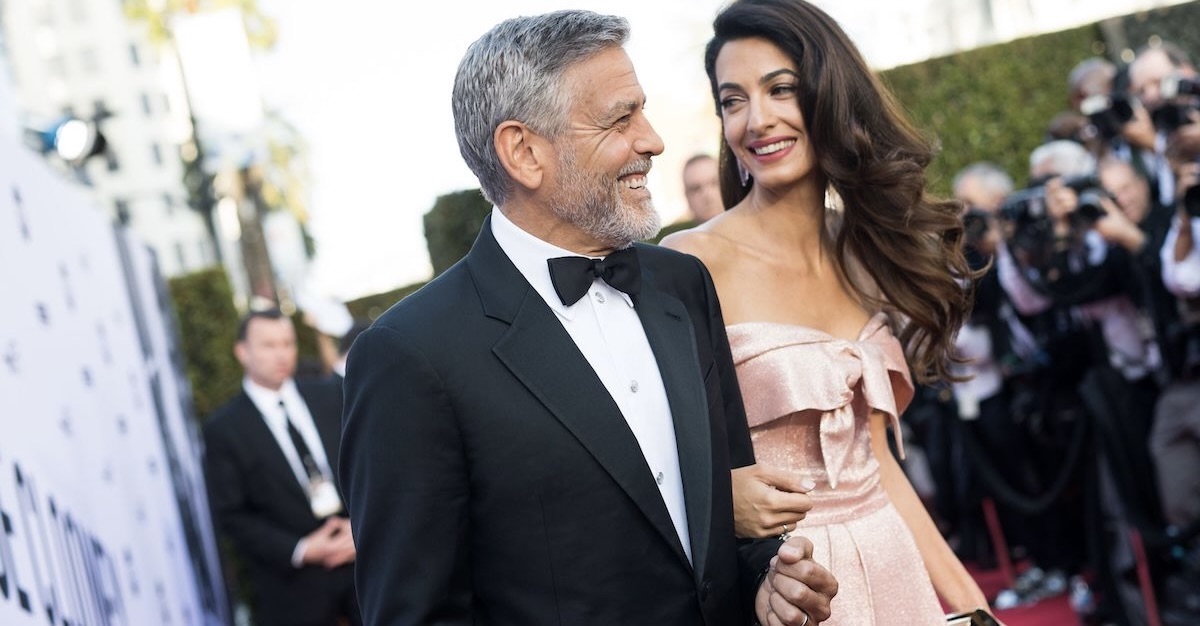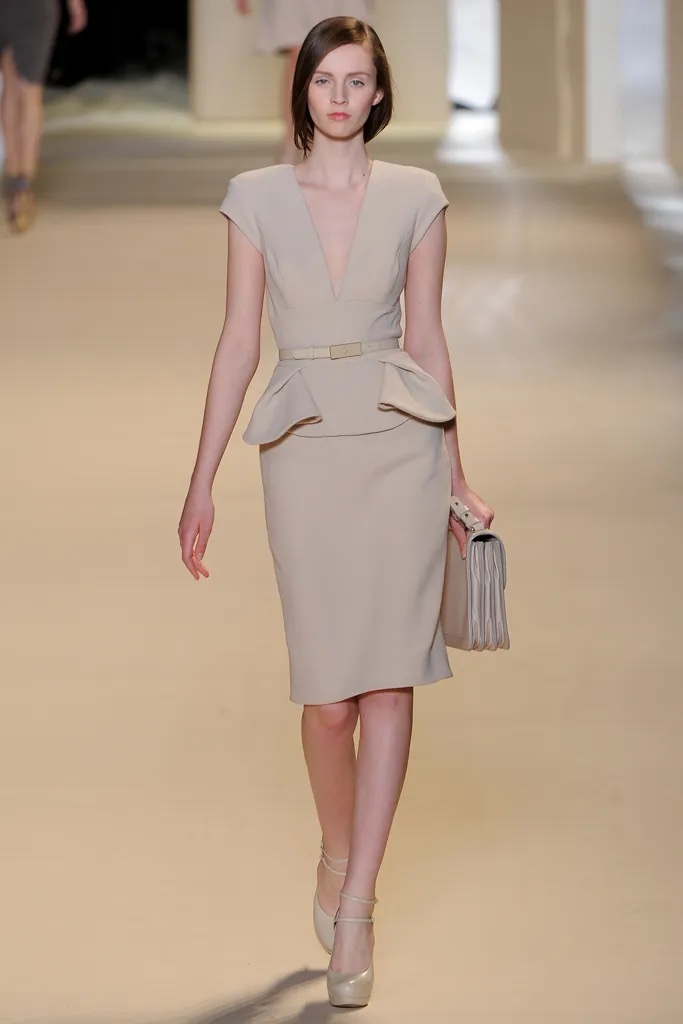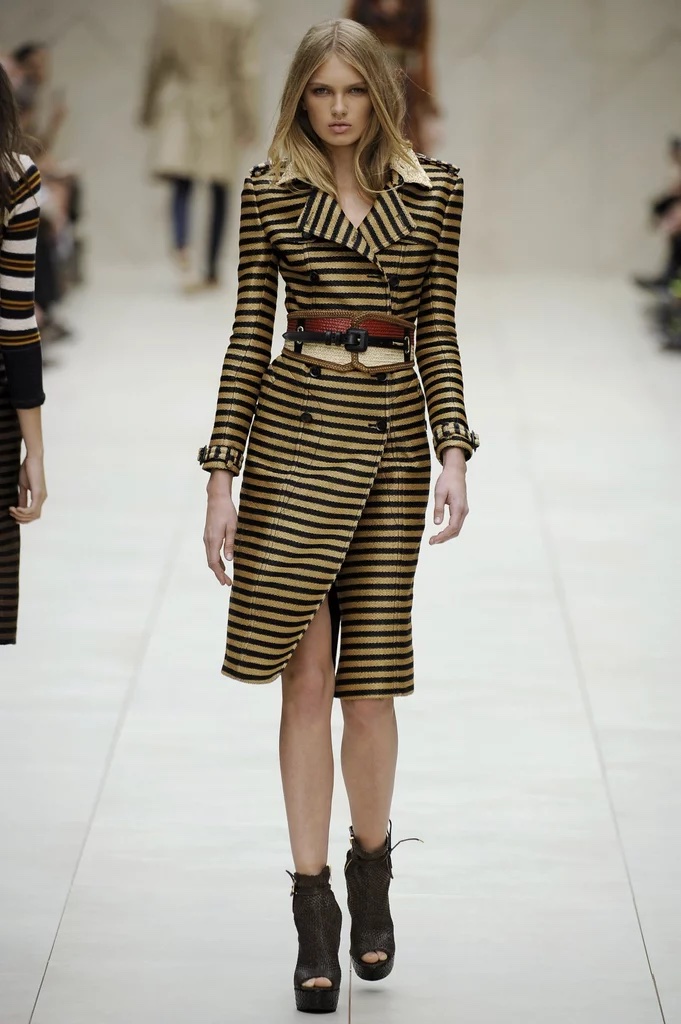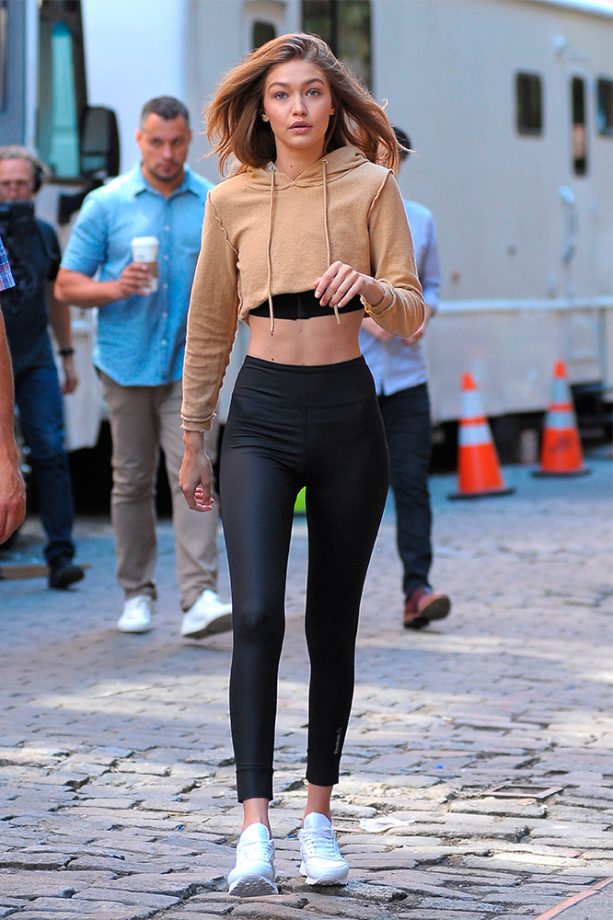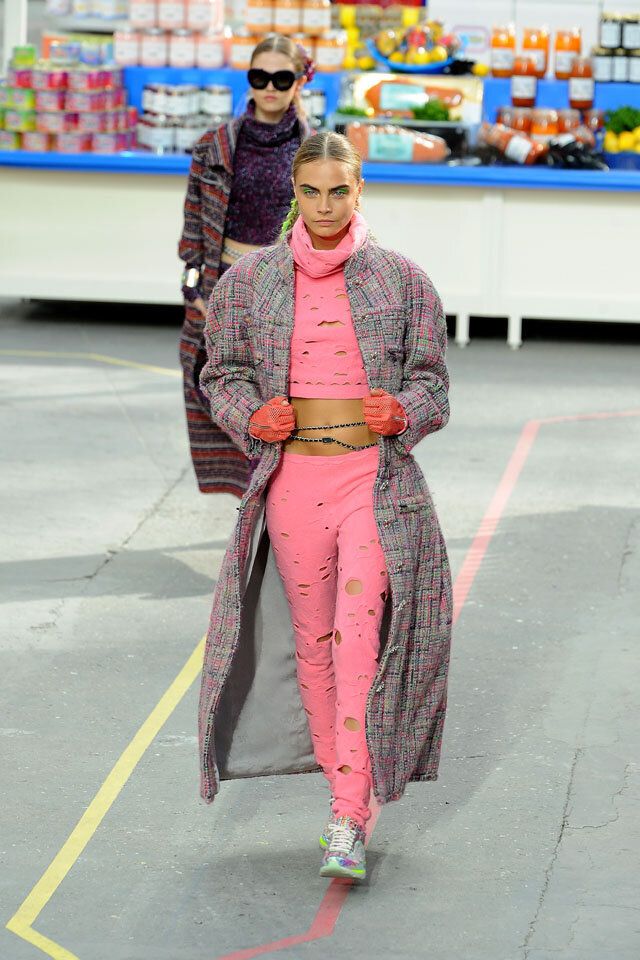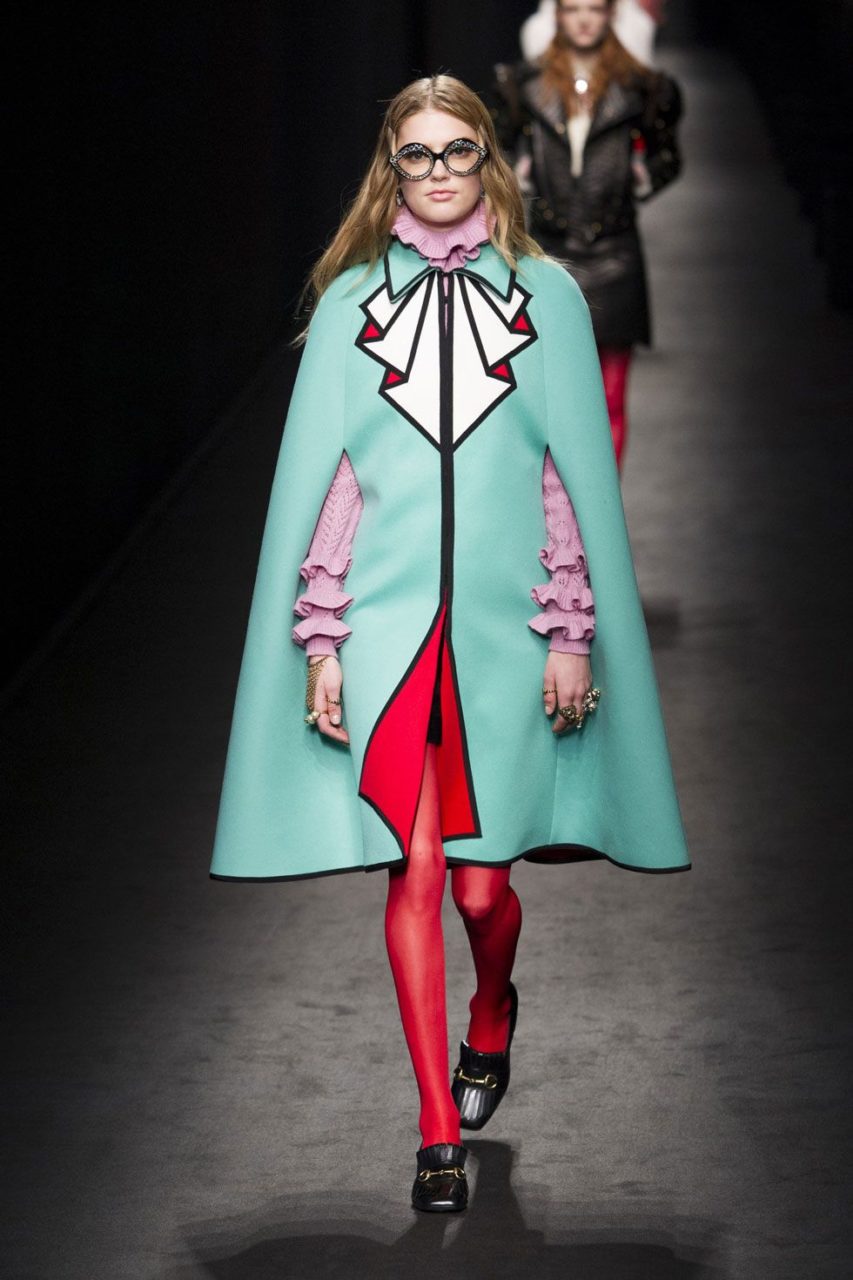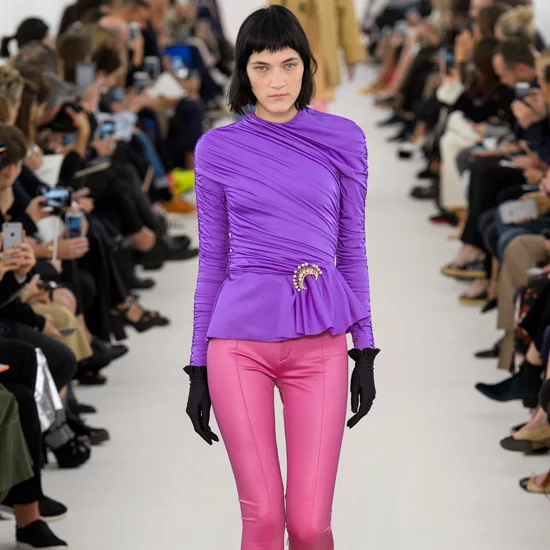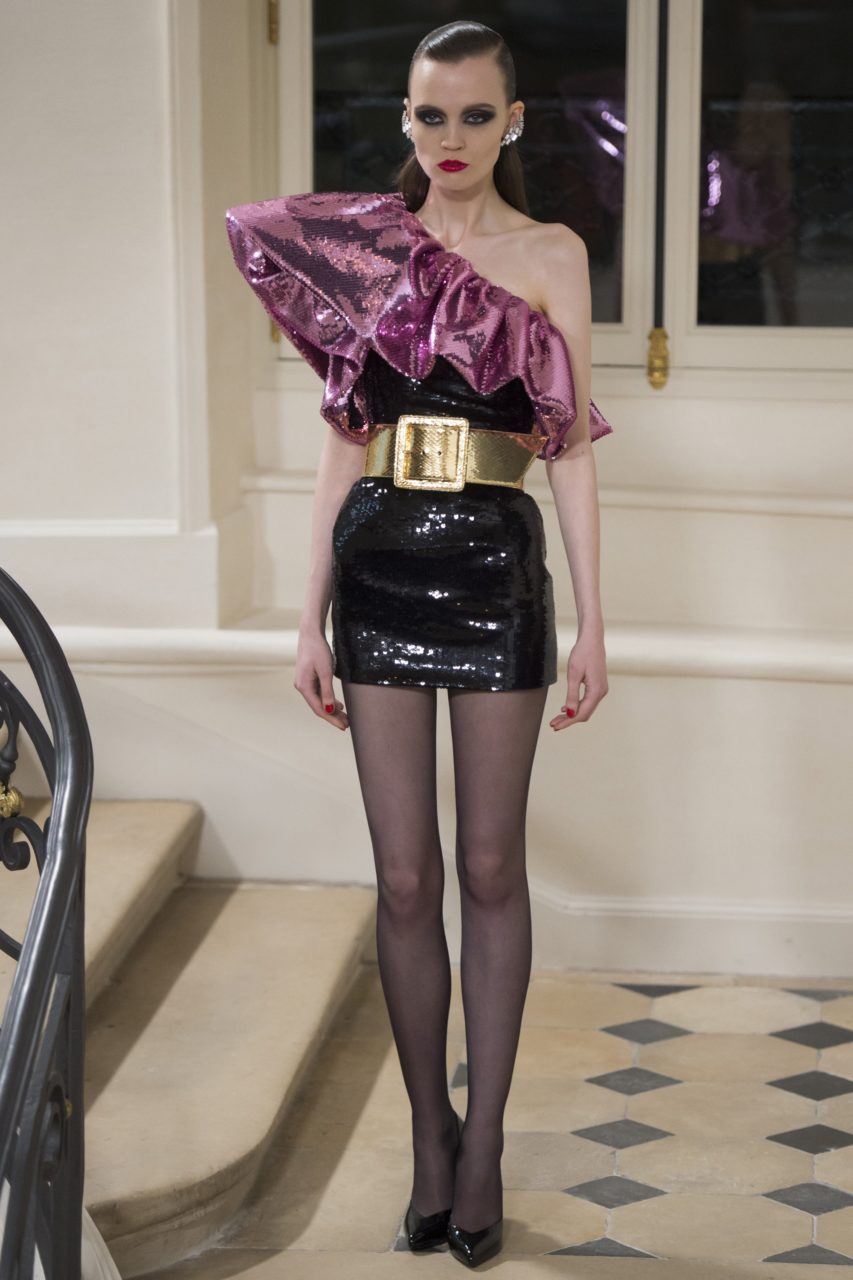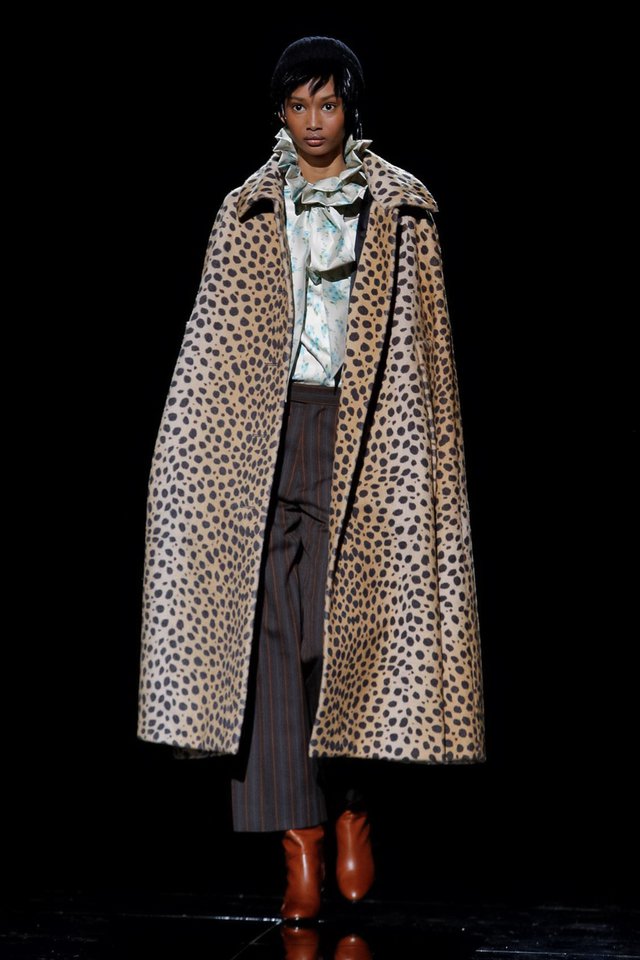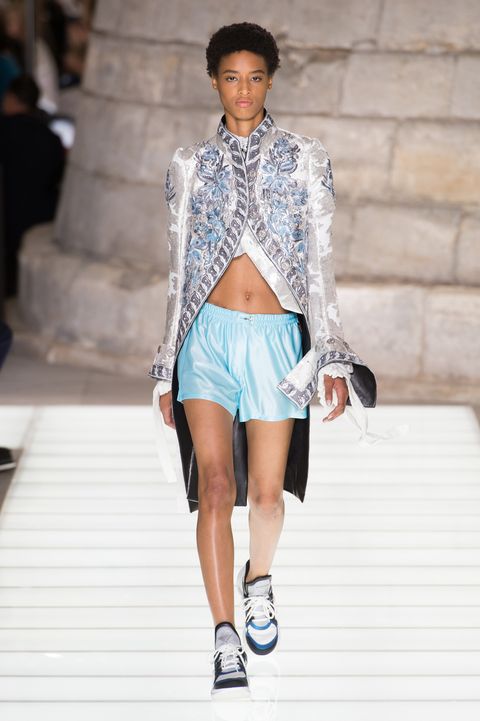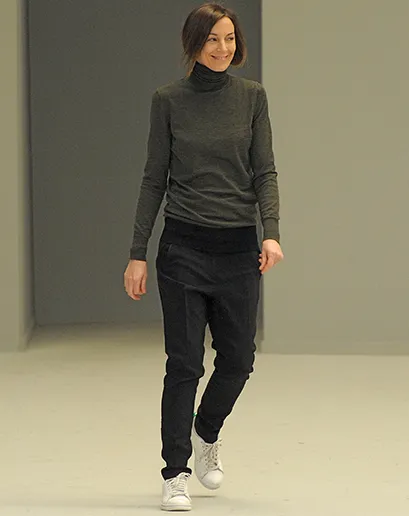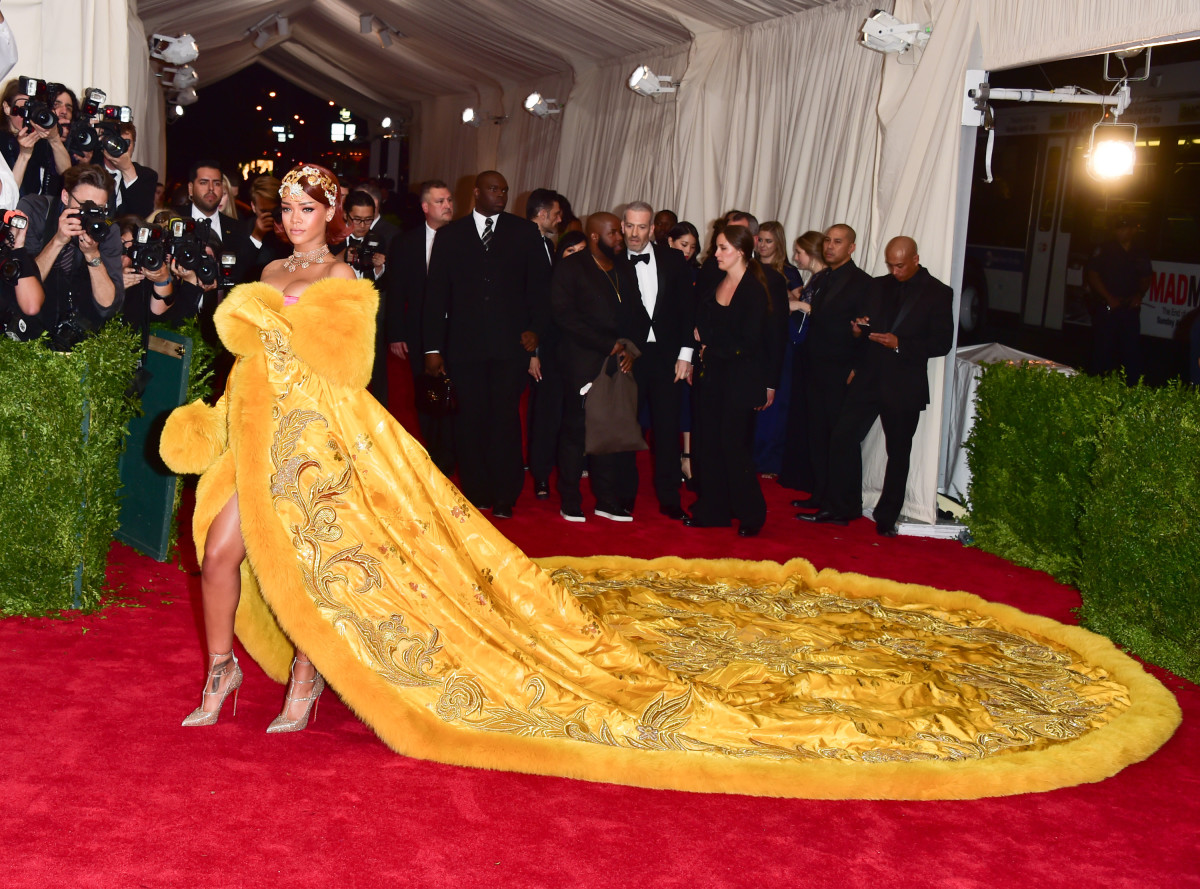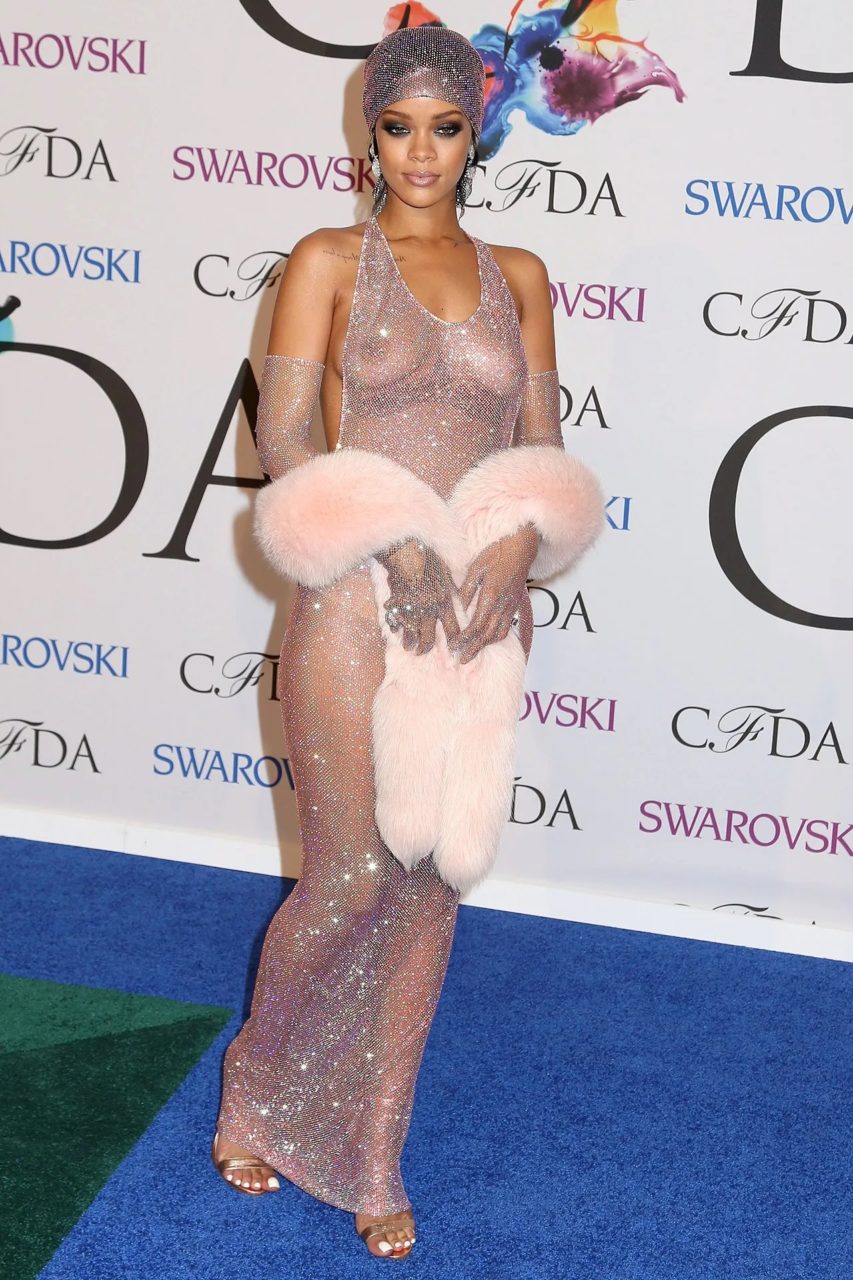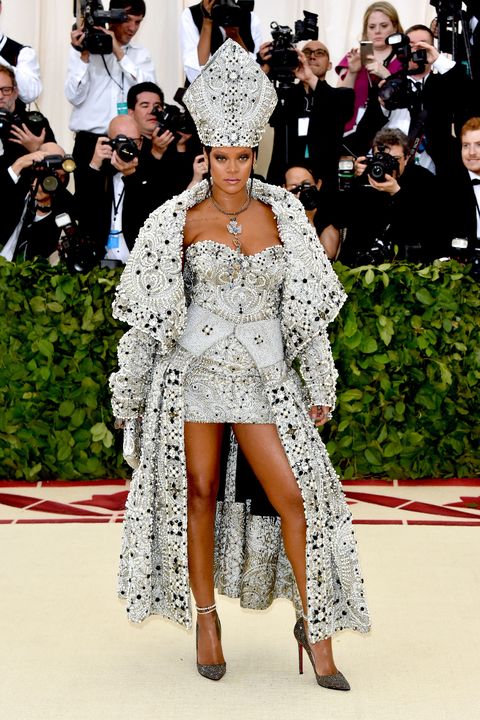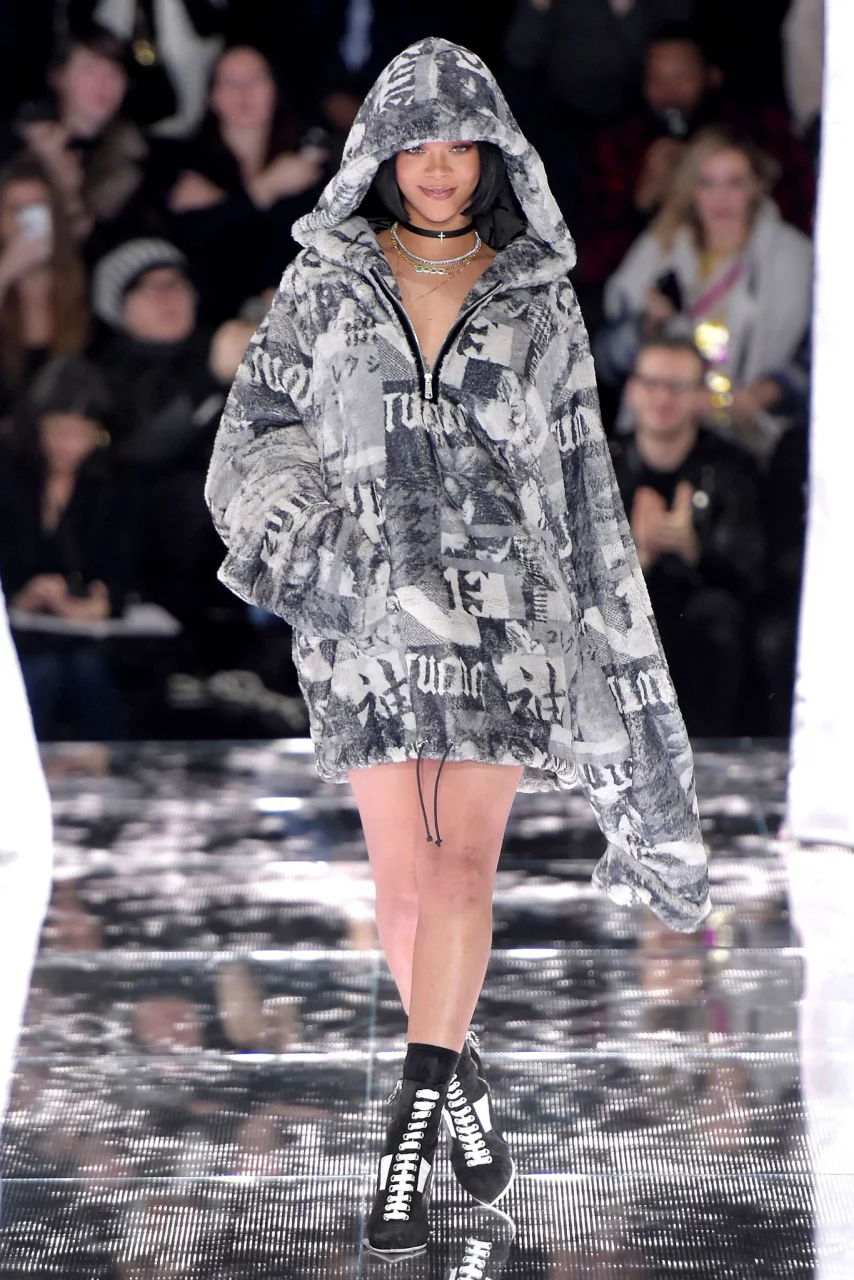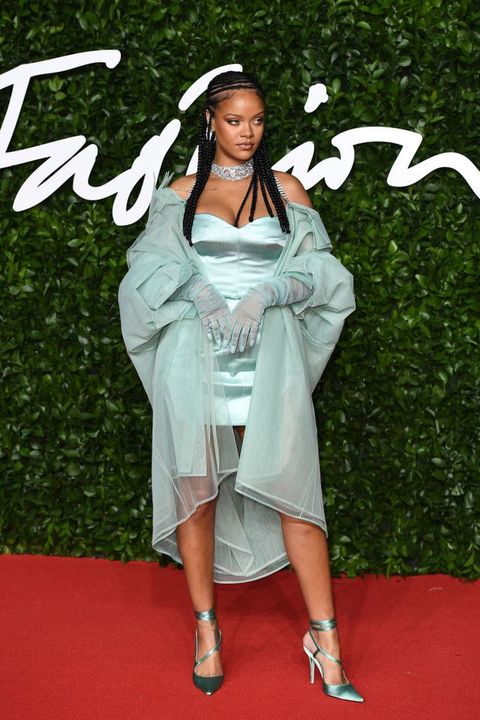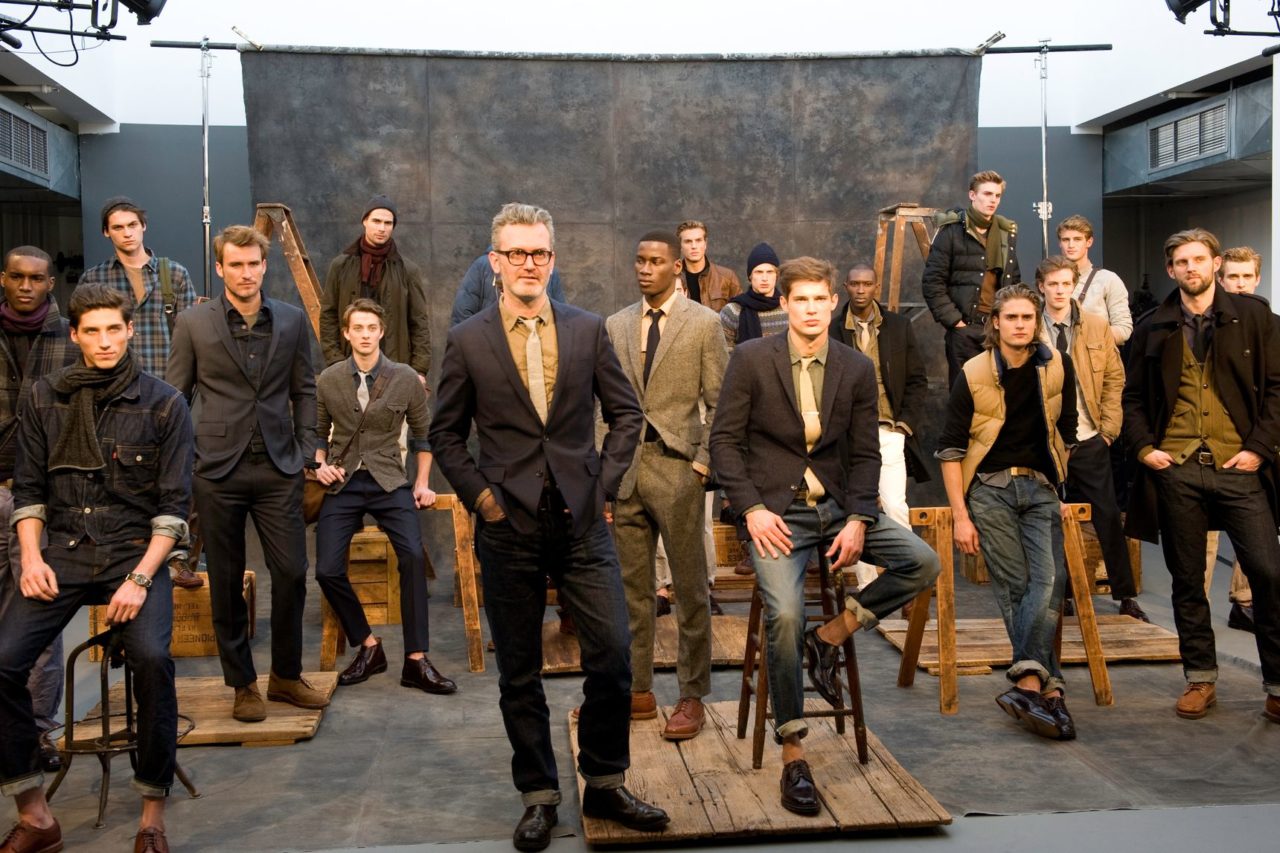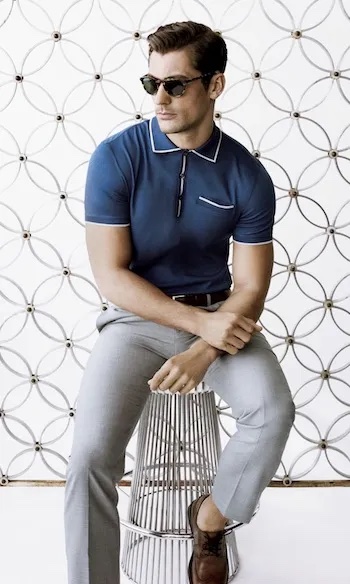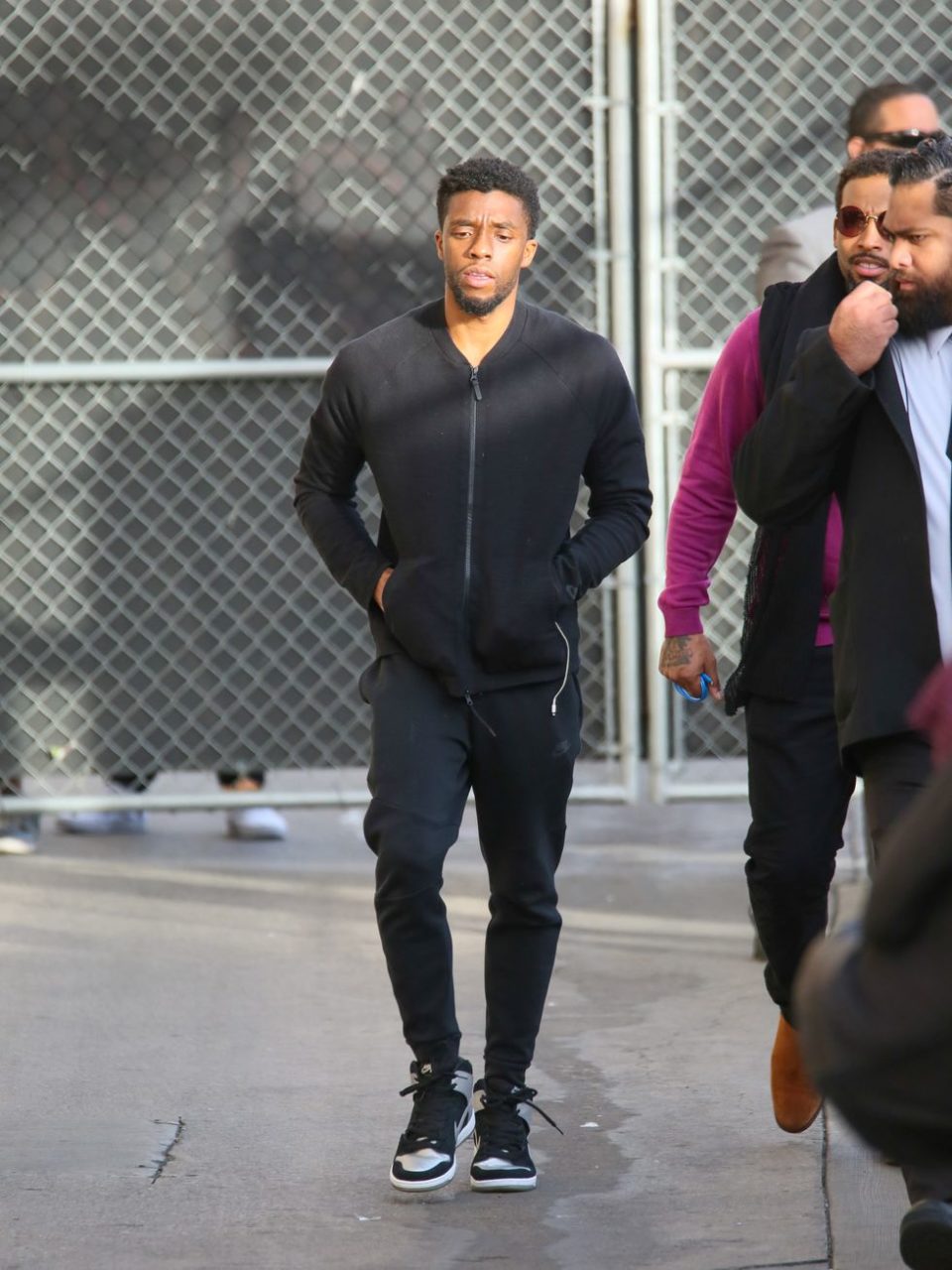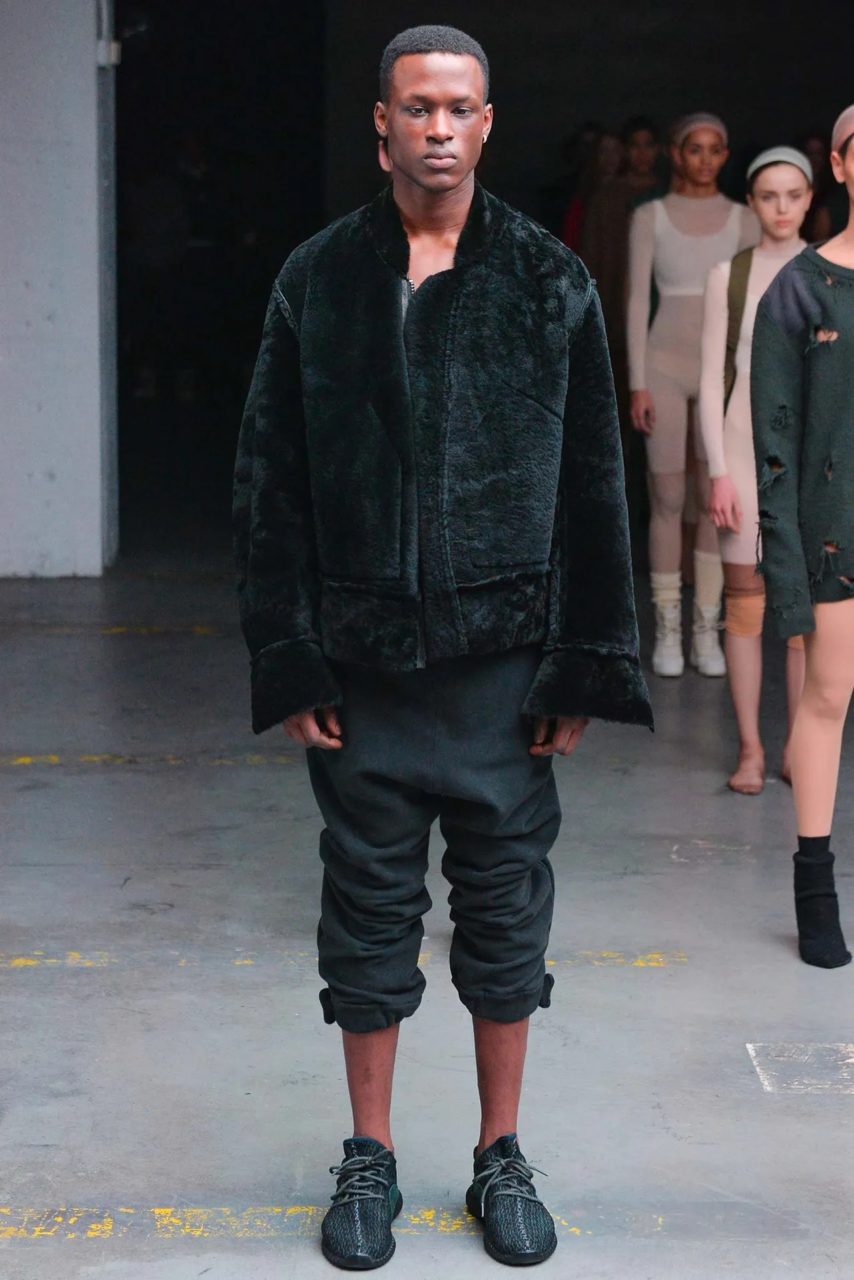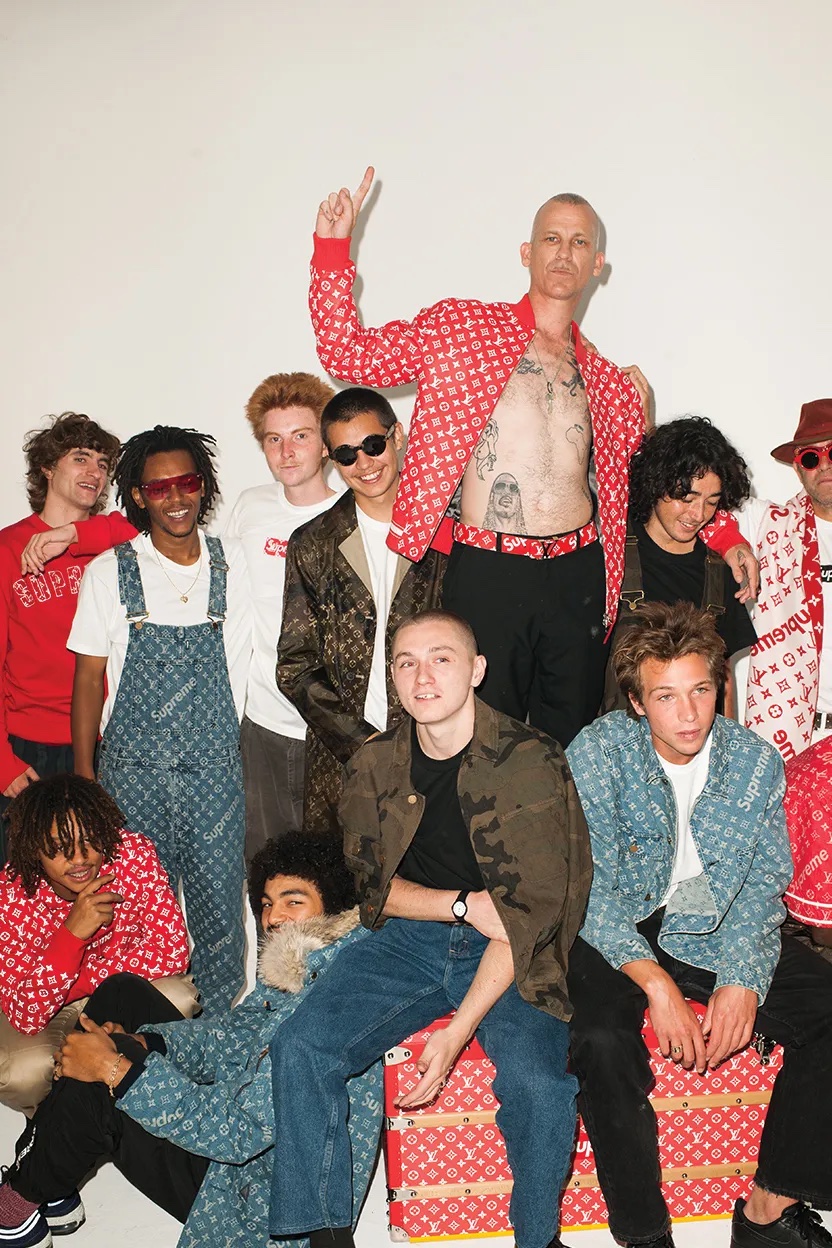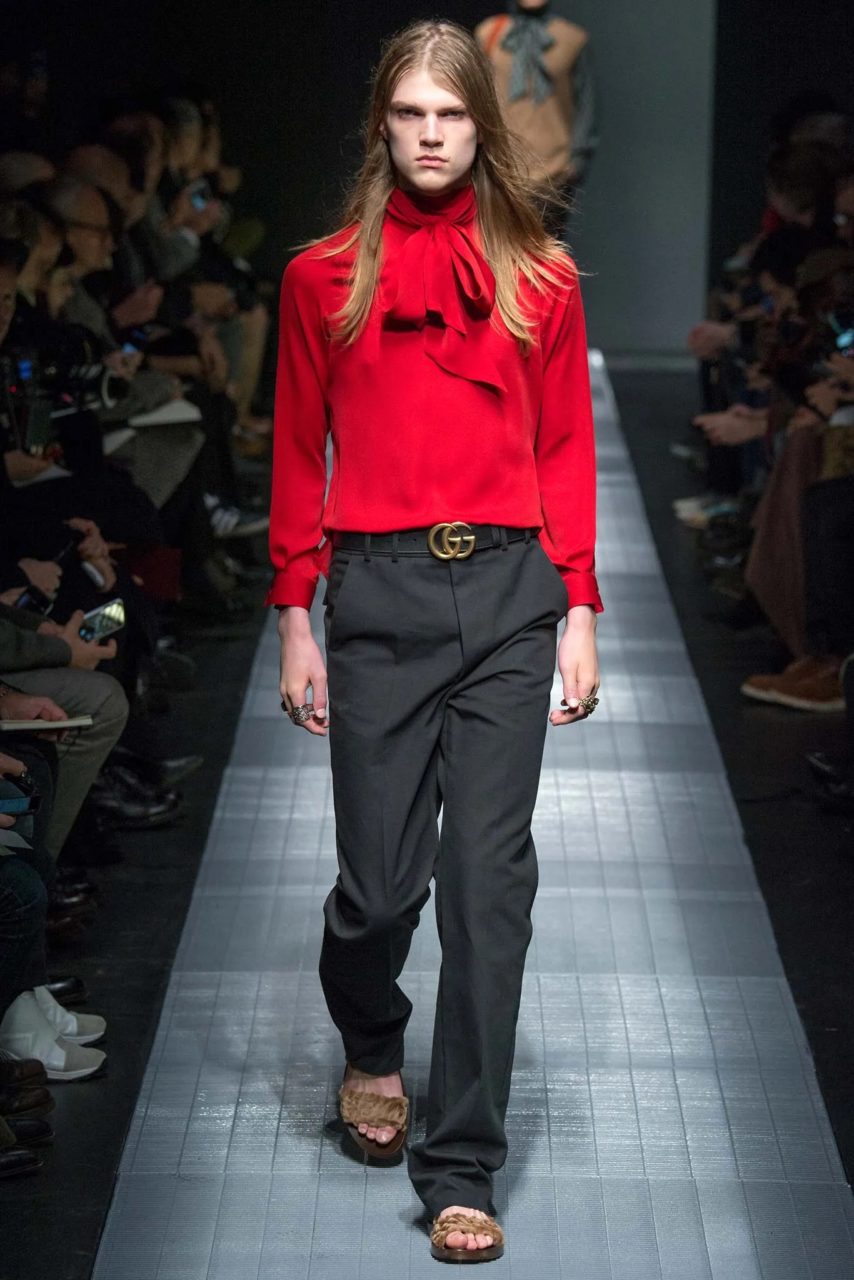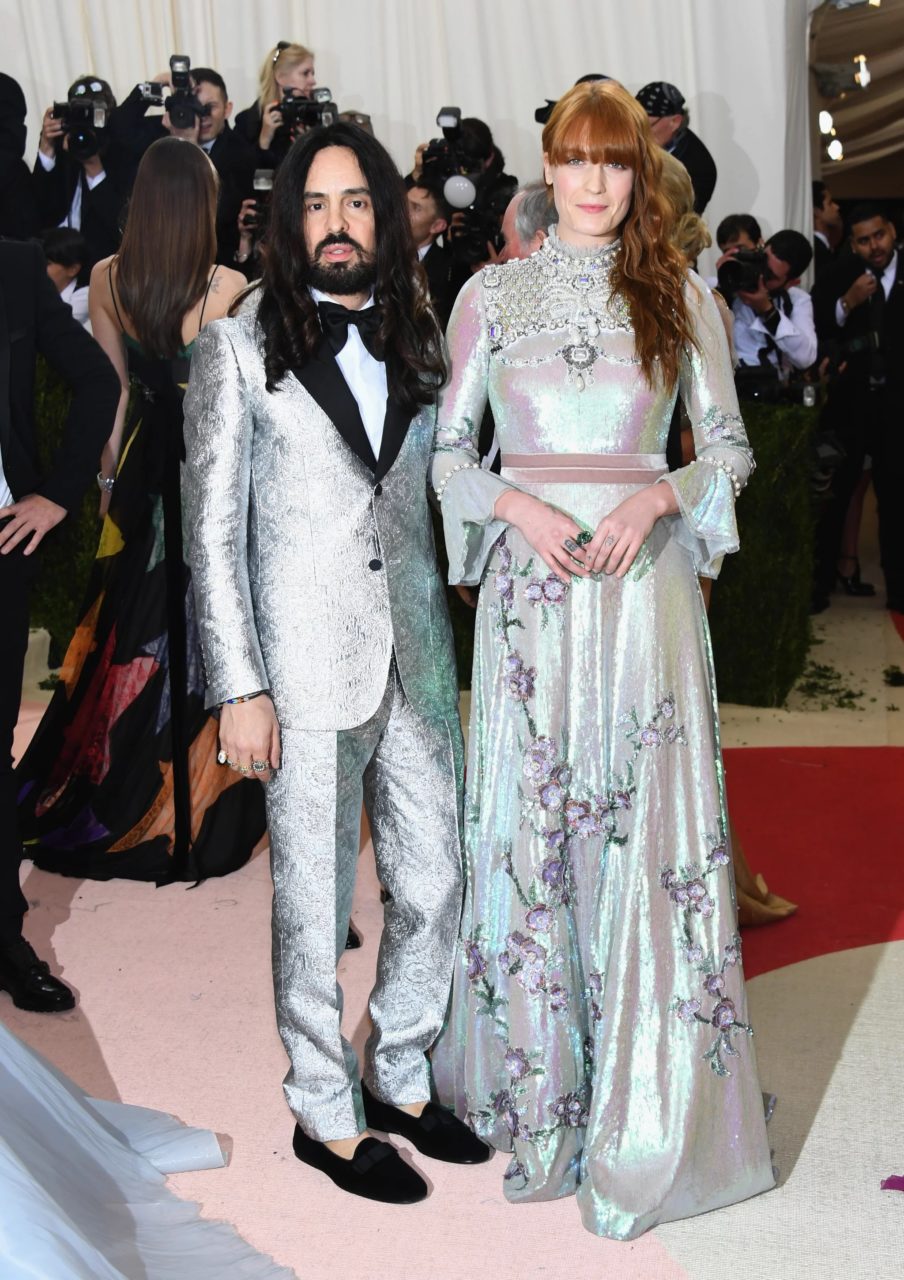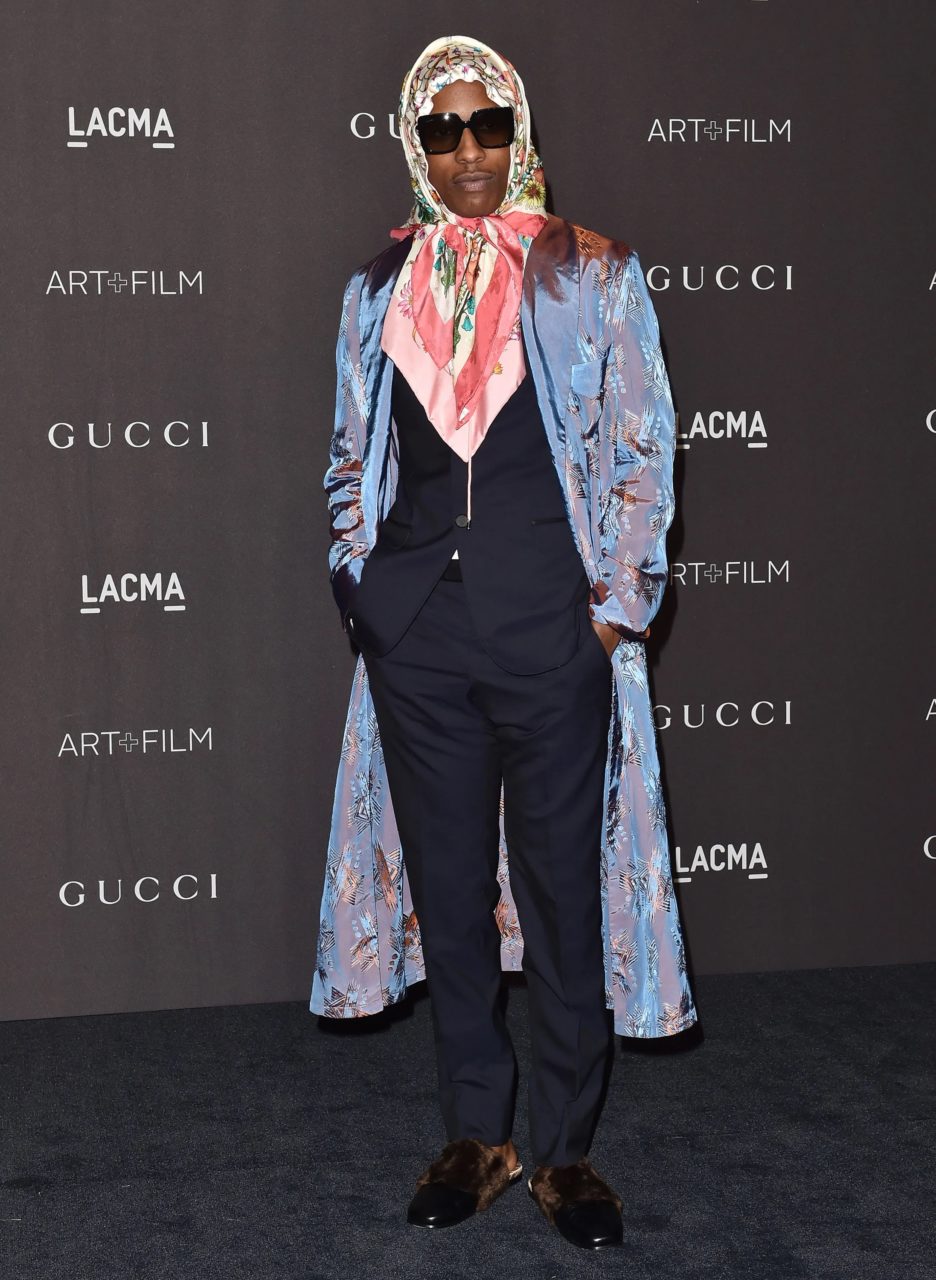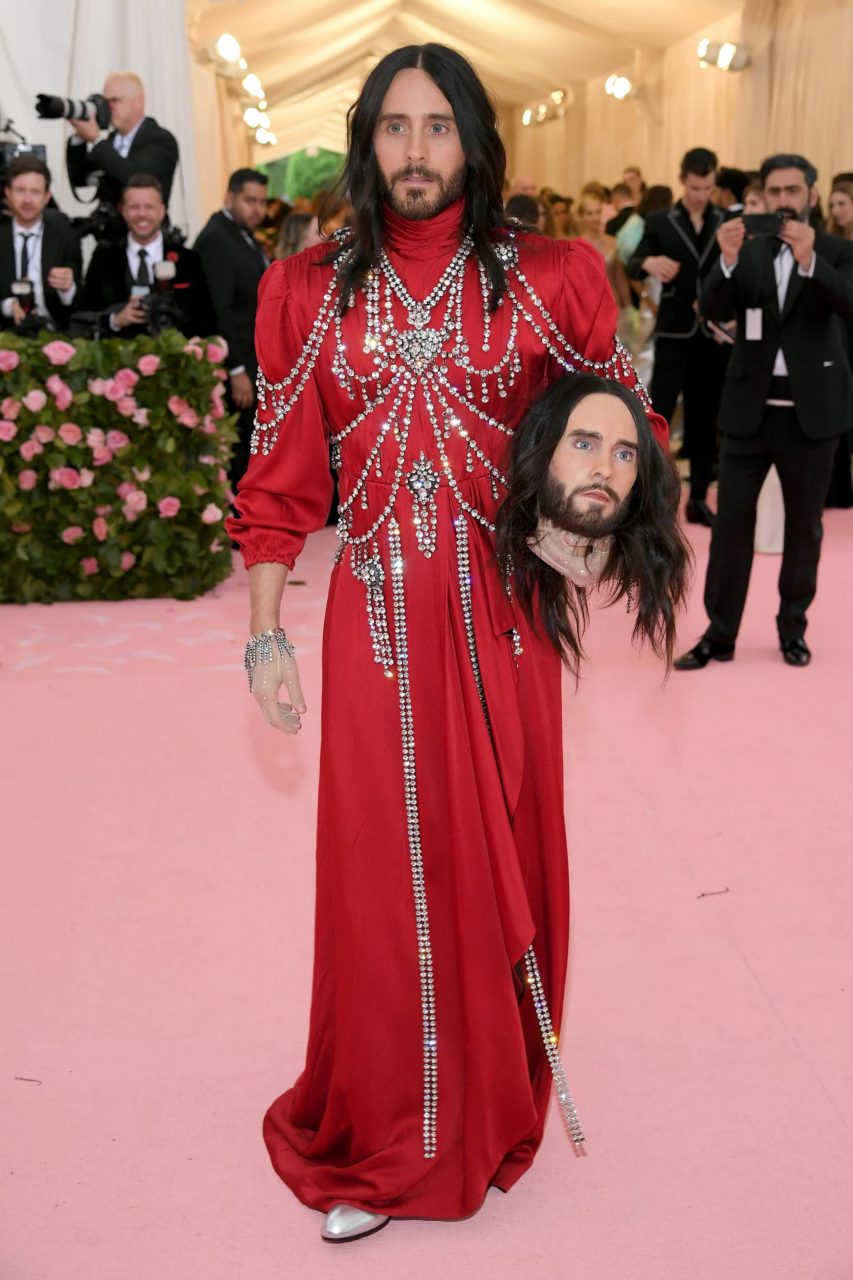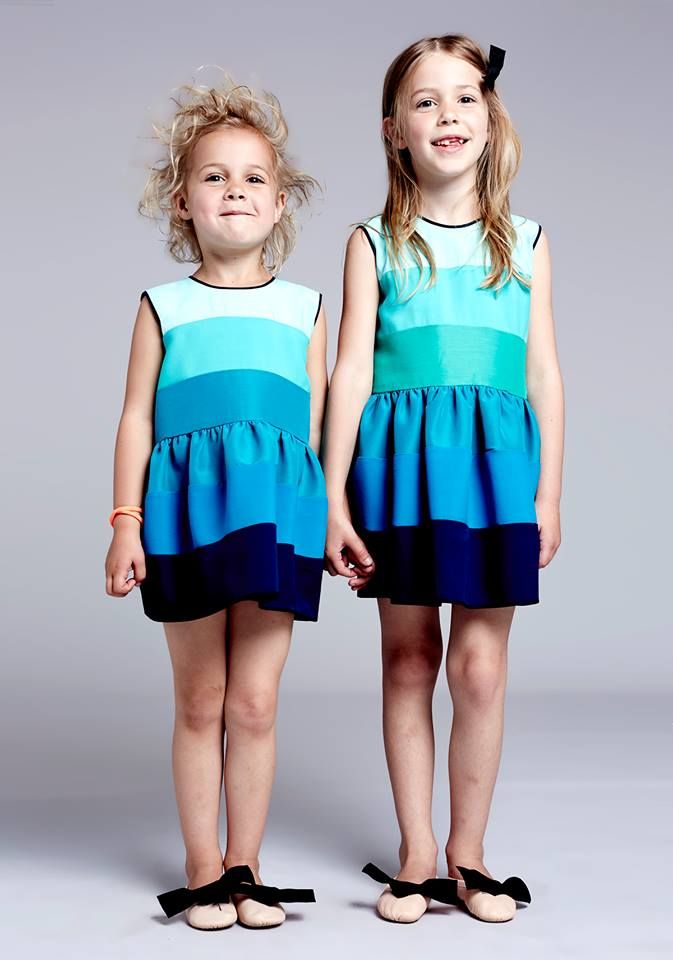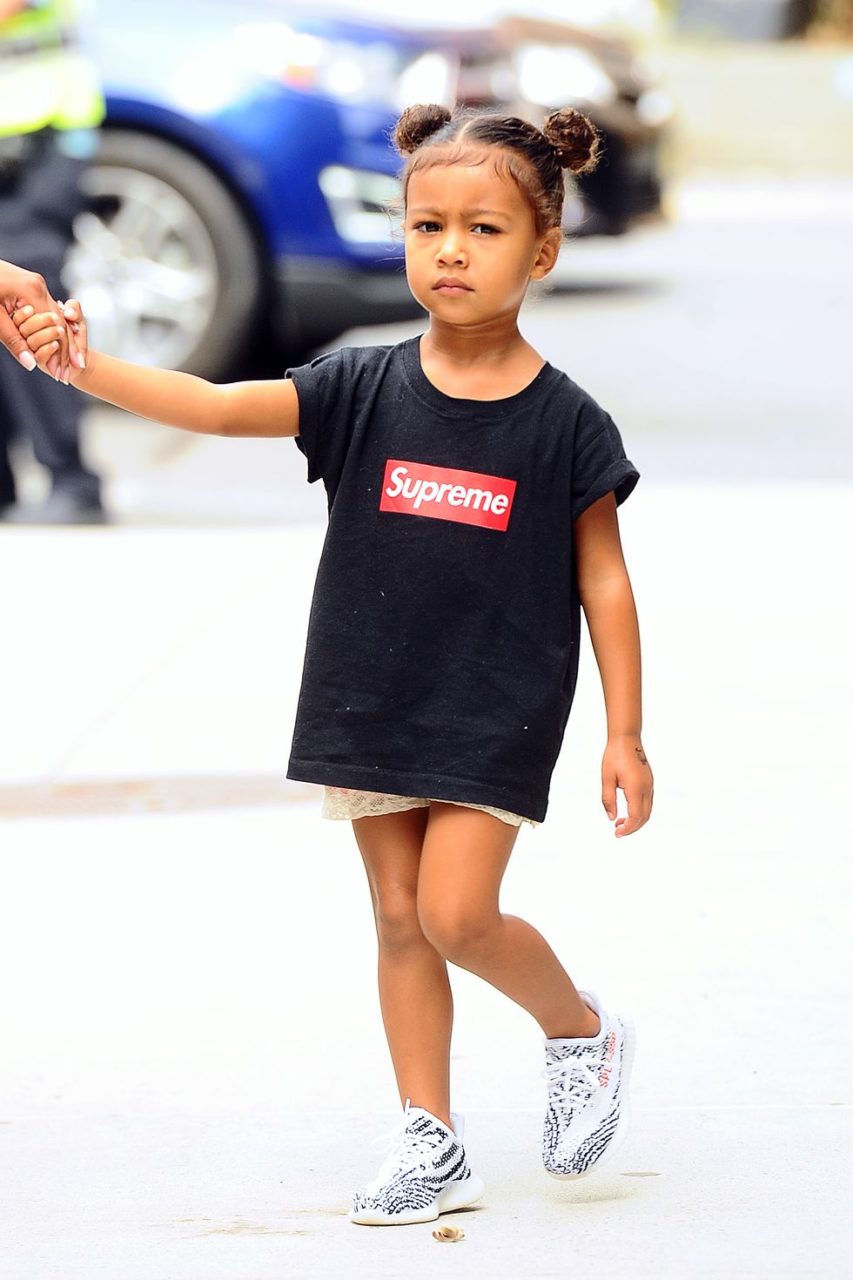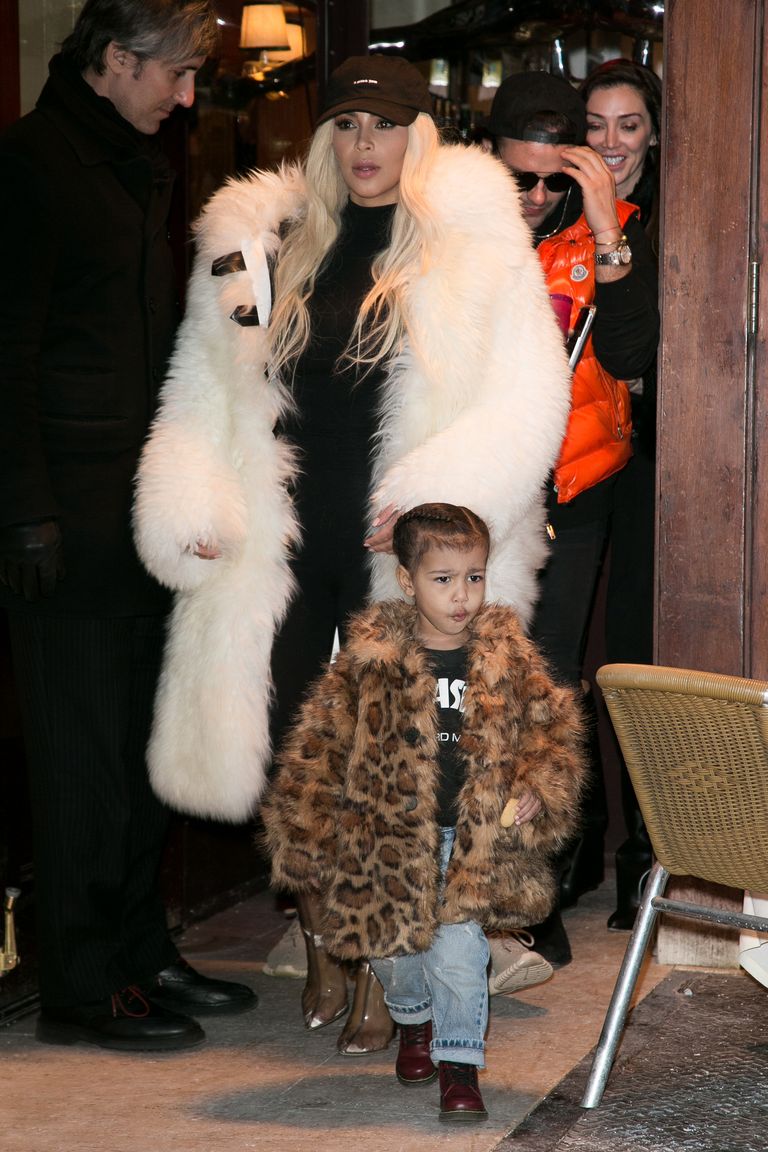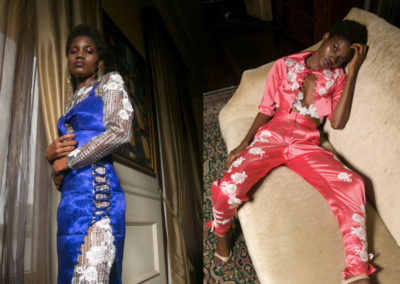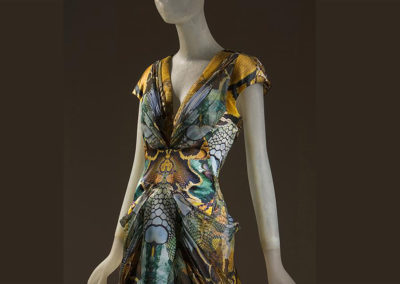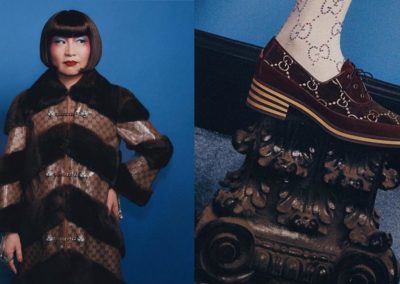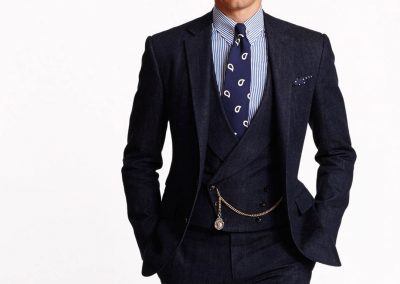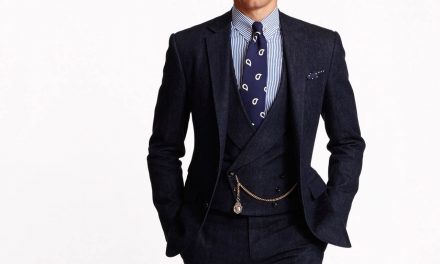OVERVIEW
Womenswear
A
s always, the line between decades blurred with the 1940s and 1980s-inspired looks that began in the noughties continuing into the beginning of the 2010s. Nipped-in waists and shift dresses like those seen on the Elie Saab runway for Fall 2011 (Fig. 1), pencil skirts and cardigans, and platform heels all contributed to a feminine professional look in the early part of the decade.
This started to soften with fuller skirts inching their way towards the midi-look that would be popular in the middle of the decade. Waists remained firmly defined, often with an oversized belt to emphasize it. Phoebe Philo’s Spring 2012 collection for Celine featured wide, matching belts heavily throughout the collection, paired with overcoats, dresses, and trousers alike (Figs. 2-3). Burberry similarly employed belts in the same season, though Christopher Bailey used decidedly brighter colors for his collection (Fig. 4). The overall effect was the same: to define the waist and create a classic, feminine silhouette now veering towards a fuller 1950s look. In some cases, this also created a peplum effect, another silhouette that was popular during this period.
Fig. 1 - Elie Saab (Lebanese, July 4, 1964 -). Look 37, Fall 2011 Ready-to-Wear. Source: Vogue
Fig. 2 - Celine (French). Look 5, Spring 2012 Ready-to-Wear. Source: Popsugar
Fig. 3 - Celine (French). Look 2, Spring 2012 Ready-to-Wear. Source: Livingly
Fig. 4 - Burberry Prorsum. Look 34, Spring 2012 Ready-to-Wear. Source: Popsugar
Fig. 5 - Photographer unknown. Gigi Hadid in Athleisure, 2016. Source: Marie Claire
Throughout the 2010s, many women began wearing workout gear as an off-duty look with no intention of ever working out, a style that came to be known as athleisure. Athleisure was stylized and often luxurious. It was born out of the bourgeoning boutique fitness culture and celebrities and models including Kendall Jenner, Hailey Baldwin and Bella and Gigi Hadid embraced the style (Fig. 5). WWD’s Layla Ilchi writes (2019):
“Hyperstylized workout gear, from the ubiquitous yoga pant to sports bras, evolved with higher quality fabrics, vibrant colours and graphic patterns, spilling from the spin class to the street.”
This eventually spilled onto the runway, as well. Amidst a satirical supermarket backdrop, Cara Delevingne and her fellow Chanel models sauntered down the runway in distressed leggings, matching crop tops, and sneakers topped with oversized tweed coats at the Autumn/Winter 2014 show (Fig. 6). Later in 2016, Kanye West and Rihanna would make their mark on athleisure fashion with Yeezy and Fenty x Puma respectively.
Fig. 6 - Chanel (French). Look 1, Fall 2014 Ready-to-Wear. Source: HuffPost UK
Fig. 7 - Gucci (Italian). Look 24, Fall 2015 Ready-to-Wear. Source: Vogue
Fig. 8 - Gucci (Italian). Look 5, Spring 2016 Ready-to-Wear. Source: Stylezza
2010s fashion had a pivotal moment in 2015 when the relatively unknown Alessandro Michele took over as creative director of Gucci. Having worked in the accessories department for 12 years, Michele was an unexpected choice, but he soon proved his worth with a buzzy debut for Fall 2015. That collection established a quirky, geeky Wes Anderson aesthetic that carried through his subsequent collections and injected a sense of fun into high fashion (Fig. 7). Michele continued to build on this in subsequent shows, utilizing classic Gucci accessories with fur coats (Fig. 8) and colorful trompe l’oeil detailing (Fig. 9). Michele’s Gucci shows soon became one of the most anticipated shows each season as he blurred gender lines with androgynous styles and shock-factor stunts built on the last.
The fun found in Gucci’s new aesthetic could be felt throughout fashion in the middle part of the decade. Bright colors and bold textures hinted at the maximalism that was to come at the end of the decade. Demonstrating how far this maximalism could go, Demna Gvasalia for Balenciaga (Fig. 10) and Hedi Slimane at Yves Saint Laurent (Fig. 11) turned back to the eighties for inspiration, complete with shoulder pads and spandex. As the decade marched towards the 2020s, that eighties influence turned into drastically oversized menswear-inspired outerwear and a vibrant array of textures. Structure, pattern, and play could be found throughout the end of the decade from Rick Owens to Rodarte.
An aristocratic thread ran through many collections with Elizabeth II-style tweeds, tartans, capes, and furs seen on the runway in the last part of the decade. In Fall 2018, Chanel’s collection featured tweed heavily, evoking the Queen, while Marc Jacobs married oversized coats, capes, silk broacade and structural gowns for Fall 2019 (Fig. 12). However, even these looks were touched by the athleisure craze. In Nicolas Ghesquière’s Spring 2018 collection for Louis Vuitton, even as models wore Louis XVI-inspired brocade coats, these were mixed with athletic shorts and sneakers (Fig. 13) while Chanel’s tweed combined with puffer coats in 2018 and delicate florals mixed with ski gear in 2019.
Fig. 9 - Gucci (Italian). Look 12, Fall 2016 Ready-to-Wear. Source: Elle
Fig. 10 - Balenciaga. Look 21, Spring 2017 Ready-to-Wear. Source: Popsugar UK
Fig. 11 - Saint Laurent. Look 40, Fall 2016 Ready-to-Wear. Source: Fashion Sizzle
Fig. 12 - Marc Jacobs (American). Look 1, Fall 2019 Ready-to-Wear. Source: SHOWstudio
Fig. 13 - Louis Vuitton. Look 1, Spring 2018 Ready-to-Wear. Source: Elle
Off the runway, Instagram burst onto the scene in 2010 and quickly gained a following. The ease with which ordinary fashion enthusiasts could share their own looks led to a huge rise in the social media influencer. Where celebrities had a massive impact on fashion in the 2000s, it was the influencer in the 2010s. Fashion bloggers gained massive followings and often the story was about what spectators wore to fashion shows rather than what actually went down the catwalk.
Early on in the decade, normcore eschewed the perfectly styled looks of high fashion for a minimalist approach. Ilchi writes,
“Normcore was meant as the antidote to the overly stylized runways and designer goods. Instead, the trend put an emphasis on mundane, casual looks that historically were interpreted as anything but fashionable.”
Aided by an interest in Scandi style, this included muted, neutral colors and perhaps one of the most enduring pieces of the style: the sneaker. After Phoebe Philo wore a pair of Adidas Stan Smiths at the end of Paris Fashion Week in 2011 (Fig. 14), white sneakers became a trend of the decade, being worn by women with everything from leggings to jeans to dresses and skirts throughout the decade with trainers sales overtaking heels sales in the UK by 2016 (De Klerk).
There were also controversies. While fast fashion continued to explode throughout the decade, the environmental and ethical costs began to come under scrutiny. The Rana Plaza collapse in 2013 shed an ugly light on the working conditions of the factory workers who make our clothes (Fig. 15). While the disaster that killed over one thousand people garnered worldwide attention and condemnation, it also forced brands and consumers to think about who makes their clothes and their wages and working conditions. Though the disaster, and others like it, outraged consumers, by the end of the decade, other than more awareness of the issue, not much had changed as the lure of fast fashion held.
Similarly, a focus on sustainability caused many consumers to think twice about their fashion choices and its impact on the environment. But thinking twice and doing something were two separate things. Though many brands made gestures towards becoming more sustainable, as with the working conditions of factory workers, substantial change was not forthcoming.
Despite moves towards more diversity and inclusion throughout the industry, several brands were rightly called out for racist products and campaigns. In a tumultuous decade, the designers behind Dolce & Gabbana created controversy after controversy. In 2012, their collection for Spring 2013 featured Blackamoor earrings and screen printing, ignoring the connotations of slavery the imagery produced. Later in 2016, the brand would come under further fire for describing a pair of shoes as “slave sandals” on their website. Then, in 2015, Domenico Dolce spoke out against in vitro fertilization (IVF), which was widely seen as a homophobic statement. In 2018, a culturally insensitive video ahead of a huge show in China found them under the spotlight for racism once again. This was made worse by Instagram DMs seemingly showing Stefano Gabbana making further racist comments about China (the brand maintains that the account had been hacked).
While Dolce & Gabbana had several incidents, they were by no means alone. In 2018, Prada was called out for figurines that echoed the racist cartoonish imagery of Sambo and blackface. They pulled the pieces and apologized, but for many, the damage was done. Similarly, Gucci had to pull a balaclava-style sweater that looked eerily like blackface when worn.
Throughout the 2010s, technology and social media allowed more and more people to engage with fashion. But the same platforms that allowed fashion to be enjoyed by all also shone a light on the ugly side of fashion in a way that had not been done before.
Fashion Icon: Rihanna
Though she emerged as a pop star in the 2000s, the 2010s cemented Rihanna as a fashion icon. While many of her biggest fashion moments of the early part of the decade came from her music career, by 2014, she was named CFDA’s Fashion Icon of the Year. Cementing this status, she wore a naked dress covered in 250,000 Swarovski crystals complete with matching opera gloves by Adam Selman (Fig. 2).
From there, she had standout fashion moment after standout fashion moment. From Guo Pei at the 2016 Met Gala (Fig. 1) to Maison Margiela in 2018 again at the Met Gala (Fig. 3), Rihanna showed up in iconic look after iconic look.
Fig. 1 - George Pimentel. Rihanna in Guo Pei at the Met Gala, 2016. Source: Fashionista
Fig. 2 - PA Photos. Rihanna in Adam Selman at the CFDA Awards, 2014. Source: Glamour UK
Fig. 3 - Getty Images. Rihanna in Maison Margiela at the Met Gala, 2018. Source: Harper's Bazaar
Fig. 4 - Unknown. Rihanna at the Fenty x Puma show, 2016. Source: WWD
Yet it wasn’t just on the red carpet that she was making waves. In 2016, Rihanna was appointed creative director for Puma and launched Fenty x Puma, tapping into the athleisure market and making her mark on fashion from the inside (Fig. 4). The collaboration lasted two years and branched from shoes into clothing. Of her influence on fashion and increasing diversity in the fashion industry, Hannah Marriott wrote in The Guardian’s review of the September 2017 Fenty x Puma show,
“Not only were the models at the show ethnically diverse and exuberant but, on the preceding Friday, she launched her own beauty line, which, with 40 shades of foundation, is once [sic] of the most inclusive beauty ranges ever.”
Following her success with Puma, and subsequently, Fenty Beauty and lingerie brand Savage x Fenty, LVMH gave Rihanna her own fashion brand in 2019, making her the first woman of color to head a brand at the conglomerate. Closing out a fantastic decade, Rihanna won a British Fashion Award in the Urban Luxe category in December 2019, looking fantastic in mint green Fenty, of course (Fig. 5). Whether on or off the runway, Rihanna was making waves throughout the 2010s.
Fig. 5 - Jeff Spicer. Rihanna at the British Fashion Awards in Fenty, 2019. Source: Elle
Menswear
A
t the beginning of the decade, men’s fashion had a traditional feel. Inspired by Don Draper on Mad Men, slim-cut grey suits became ubiquitous as a revival of the classic mid-century look spread. The look was finished by its accessories: skinny ties and pocket squares. Retailers were happy to oblige with J.Crew, Banana Republic, and Brooks Brothers all launching Mad Men-inspired lines in the early part of the decade, including J.Crew’s Ludlow suit (Fig. 1) and Banana Republic’s collaboration with the show’s costume designer, Janie Bryant (Fig. 2). As the decade wound to a close, Esquire’s Jonathan Evans wrote:
“By the early 2010s, the J.Crew Ludlow suit, launched a year after Mad Men in 2008, was ascendant (and never without a pocket square in the breast pocket). In 2011, the show’s costume designer, Janie Bryant, teamed up with Banana Republic on a capsule collection inspired by the men of Sterling Cooper.”
Impeccable tailoring, pocket squares, and monk strap shoes formed a period of dandyism for men that was epitomized at Pitti Uomo, a twice-yearly event for menswear in Florence, Italy.
The retro-inspired style also spread to casual wear. Shawl collars, cardigans, and cable knit sweaters were popular options that would later, along with flannel shirts and skinny jeans, form the hipster look. Contrary to its alternative roots, hipster style became mainstream in the early 2010s for both men and women. Men’s hipster style essentials included waistcoats worn with jeans, horn-rimmed or thick glasses (whether you needed them or not), groomed beards, and man buns. The look was a natural progression from the 1960s-inspired tailoring, with elements of suiting, oxfords and brogues, and skinny ties all contributing to the style.
Fig. 3 - Bauer-Griffin. Actor Chadwick Boseman in jogger pants, 2018. Source: Elle
Fig. 4 - Kanye West x Adidas Originals. Look 1, Fall 2015 Ready-to-Wear. Source: Vogue
Fig. 5 - Supreme x Louis Vuitton. Promotion image for the Supreme x Louis Vuitton collaboration, 2017. Source: GQ
As the decade progressed, however, menswear became more and more casual. Athleisure and streetwear-inspired men’s fashion spread in the middle part of the decade with items such as sweatpants, hoodies, and t-shirts being acceptable to be worn anywhere. Jogger pants–sweatpants that tapered to an elastic band at the ankle–rose in popularity and expensive, luxury versions were available by the middle part of the decade as they were embraced by celebrities like Chadwick Boseman (Fig. 3).
Part of the style’s appeal was its ability to show off expensive sneakers, another mainstay of men’s athleisure fashion in the 2010s. Arguably the most talked about sneaker of the decade, and certainly of the mid-part of the decade, was the Yeezy, a collaboration between Kanye West and Adidas that proved to be one of the most popular sneakers for both men and women. First released in 2015 alongside Kanye’s sportswear collection with Adidas (Fig. 4), the Yeezy Boost 350 has had countless new versions and colors released since and continues to be highly anticipated by sneaker enthusiasts.
While Yeezys were the ultimate fashion sneaker, sneakers, in general, played a role in both the athleisure and streetwear styles of the mid- to late-2010s. Styles stemmed from skater brands Supreme and Palace, which prized logos and collaborations, as seen in Supreme’s collaboration with Louis Vuitton in 2017 (Fig. 5). Logos, whether they be the brand logo or a randomly chosen brand, were popular. In 2015, fellow designer Gosha Rubchinskiy took part in Vetements’ Spring 2016 show wearing a yellow DHL–the shipping company–t-shirt (Fig. 6). Streetwear designers Virgil Abloh of Off-White (Fig. 7), Denma Gvasalia of Vetements (and later Balenciaga) and Rubchinskiy rose to prominence in the middle part of the decade helping the proliferation of casual styles previously seen only on the streets. Gvasalia, from Georgia, and Rubchinskiy, from Moscow, showcased influences from their Soviet upbringings, creating a clash of east and west in their styles.
Fig. 6 - Vetements. Look 1, Spring 2016 Ready-to-Wear. Source: Vogue
Fig. 7 - Christian Vierig. Virgil Abloh, ca. 2020. Source: Vogue Business
Fig. 8 - Gucci (Italian). Look 1, Fall 2015 Menswear. Source: Vogue
Fig. 9 - Larry Busacca. Alessandro Michele and Florence Welch at the 2016 Met Gala, 2016. Source: Popsugar
Fig. 10 - Getty Images. A$AP Rocky, 2019. Source: Vogue
Fig. 11 - Unknown. Jared Leto in Gucci at the 2019 Met Gala, 2019. Source: Popsugar
In the later part of the decade, there was a return to suits, but not the 1960s-inspired grey suits of Mad Men. Instead, these were bold, irreverent takes on traditional silhouettes that show men playing with fashion. Inspired by Alessandro Michele’s designs for Gucci menswear (Fig. 8), from the middle part of the decade, men began experimenting with styles, textures, and patterns we have traditionally (in the past few centuries at least) associated with womenswear, marrying the materials with traditional suit silhouettes, as Michele did at the Met Gala in 2016 (Fig. 9). Actors and celebrities from Harry Styles to A$AP Rocky to Ryan Gosling to Prince William embraced Michele’s vision of menswear wearing floral suits, brocade or velvet jackets, silk scarves (Fig.10), and even, in the case of Jared Leto at the Met Gala, gowns (Fig. 11). While elements of the styles mirrored those of Mad Men-inspired looks of the beginning of the decade–suits, loafers, sweater vests, button-downs–they were styled in ways that Don Draper wouldn’t have recognized. As Evans wrote for Esquire:
“…he’s upending our collective idea of how the modern man might dress while wearing suits, and high-waisted trousers, and sweater vests—the stuff of ‘60s closets, just taken to a whole other plane of existence.”
As the decade closed, elements that were popular throughout the decade continued to be present in men’s fashion, though with a fresh take. From suiting to chunky sneakers to logos, while many elements stayed the same, by the end of the decade, men had started having fun with fashion in a way that had traditionally been left to women.
CHILDREN’S WEAR
Fashion made its way into children’s wear in a way it never had before in the 2010s. The children of celebrities became mini-influencers in the age of social media and luxury brands took notice. In the first few years of the decade, Stella McCartney, Roksanda Ilincic, Lanvin, Marni, Gucci, Fendi, and Dolce & Gabbana all launched children’s lines. These labels used their signature styles but tailored them for a younger audience, like Roksanda Ilncic’s Blossoms label which carried through her use of color blocking and geometric shapes in silhouettes that would suit young girls (Fig. 1). Following in the footsteps of Blue Ivy and North West, the luxury children’s lines enabled parents to dress their children as mini-adults. While this was the top-end of the market, the effect was felt across children’s wear. In the first five years of the decade, children’s wear outpaced both womenswear and menswear (Abnett).
Children’s clothing often imitated their adult counterparts. Polo Ralph Lauren saw their children’s line use the same styles of sweaters, blazers and button-ups with added flair for kids (Fig. 2). Kate Abnett wrote in Business of Fashion in 2016:
“At the high-street level, children’s clothing has begun to imitate adult clothing, as parents’ desire for their children to be ‘on-trend’ has increased and their consumption habits have shifted towards more frequent purchases.”
This was epitomized by Kim Kardashian and Kanye West’s daughter North as she wore designer clothes that could have been taken off a womenswear runway. From Yeezys and Supreme (Fig. 3) to Doc Martens and a fur coat (Fig. 4), North often looked like her parents’ mini-me while Blue Ivy Carter twinned with her mom Beyoncé in a tuxedo-inspired ballgown at the 2019 Lion King premier (Fig. 5). Even adult trends were followed as athleisure for children became comfortable staples to play and live in with leggings becoming a staple in girls’ wardrobes while stretchy denim helped kids play in comfort.
Fig. 3 - Unknown. North West in Supreme and Yeezys, September 2016. Source: Harper's Bazaar
Fig. 4 - Unknown. North West and Kim Kardashian West, February 2016. Source: Harper's Bazaar
Fig. 5 - Chris Pizzello. Beyoncé and Blue Ivy Carter at the Lion King premiere, July 2019. Source: Hollywood Life
Fig. 6 - NurPhoto/Getty Images. Prince William and the Duchess of Cambridge with Prince George and Princess Charlotte, 2017. Source: Glamour
Though the 2010s saw the popularity of flashy labels and athleisure for children, from the mid-part of the decade, there was also a return to traditional clothing styles for kids thanks to Kate Middleton and her children. Instead of dressing her three children, born between 2013 and 2018, in the furs, leather, and luxury labels that the Kardashians and Carters were dressing their children in, Kate chose to dress her children in more classic styles (Fig. 6). These included smocked dresses, cotton overalls, knitted sweaters and cardigans, Mary Janes and shorts for Prince George when he was very young. The clothes were akin to 1950s and ‘60s children’s wear and Kate dressed the younger two in clothes Prince George had first worn, showing the versatility of the traditional styles. Clothes seen on Prince George, Princess Charlotte, and Prince Louis would sell out soon after they were seen in them, similar to the “Kate Effect” of clothing worn by their mother.
Teen and youth fashion also saw the effects of new technologies and the rise of social media. Teens found communities in online forums and on social media, with some styles being named after the platforms. Amongst other styles that were popular for teens throughout the decade were the Tumblr Girls of the early- to mid-2010s and the VSCO Girls at the close.
Tumblr Girls, so named for the blogging site and who reached their peak in 2014, followed closely on the indie sleaze of the late 2000s. Their style incorporated elements of grunge like Dr Martens and dark colors, along with logo t-shirts (Fig. 7). Refinery29’s Maggie Zhou described their wardrobe:
“Skinny black jeans with knee rips, a pair of Doc Martens, faded band tees, fishnet stockings, chokers, and denim jackets could be found in her wardrobe rotation.”
As a sign of how quickly trends moved during the decade, while Tumblr Girls faded in the middle part of the decade, the e-girls of the late 2010s adopted elements of Tumblr Girl style, updating it with tennis skirts and striped shirts.
On the other end of the spectrum, the VSCO Girl emerged on TikTok in 2019. Named after a photo editing app, VSCO Girls typically wore oversized t-shirts over shorts, along with “ugly” shoes such as Birkenstock sandals or Crocs. They were signified by their accessories: a Hydro Flask, seashell necklace, scrunchies, metal straw, and a Fjallraven backpack. Shared on TikTok and YouTube, the term became ubiquitous as we entered the 2020s.
Fig. 7 - Christina. How to be a Tumblr Girl, December 2012. Source: Quotev
Fig. 8 - Olivia Cara. How to be a VSCO Girl Checklist, 2020. Source: Business Insider
References:
- “12 Pieces of Menswear that Defined Style in the 2010s.” Fashionbeans. Accessed May 29, 2022. https://www.fashionbeans.com/article/menswear-defined-2010s/.
- “2010s in Fashion.” Wikipedia. Accessed February 20, 2022. https://en.wikipedia.org/wiki/2010s_in_fashion.
- Abnett, Kate. “The Children’swear Market Comes of Age.” Business of Fashion, June 21, 2016. Accessed July 3, 2022. https://www.businessoffashion.com/articles/news-analysis/the-childrenswear-market-comes-of-age/.
- Ahmed, Osman and Mahoro Seward. “McQueen Skulls and Mulberry Alexas: An Introduction to Early 2010s Style.” i-D, February 7, 2022. Accessed April 3, 2022. https://i-d.vice.com/en_uk/article/m7v378/2010s-fashion.
- Ahssen, Sarah. “Burberry Taking Back the Reins of Its Childrenswear.” Fashion Network, March 24, 2015. Accessed July 3, 2022. https://ww.fashionnetwork.com/news/burberry-taking-back-the-reins-of-its-childrenswear,474848.html.
- Associated Press. “From Gucci to Prada, Luxury Fashion Brands Challenged to Confront Racist Attitudes.” USA Today. Accessed March 2, 2016. https://eu.usatoday.com/story/entertainment/celebrities/2020/06/22/luxury-fashion-brands-get-blowback-racism-gucci-prada-loreal/3234226001/.
- Baklarz, Cat. “A Brief History of Hipsters, from Social Outcast to Urban Connoisseur.” Medium, January 11, 2021. Accessed May 29, 2022. https://medium.com/exploring-history/a-brief-history-of-hipsters-from-social-outcast-to-urban-connoisseur-db373a64af04.
- Barnett, Leisa. “Burberry Coming to America.” Vogue, August 29, 2008. Accessed July 3, 2022. https://www.vogue.co.uk/article/burberry-to-launch-childrenswear-in-us.
- Beresford, Jessica. “A Decade In Fashion: The Biggest Style Moments From 2010 to 2020.” Viva, December 17, 2019. Accessed April 3, 2022. https://www.viva.co.nz/article/fashion/a-decade-in-fashion-the-biggest-style-moments-from-2010-to-2020/.
- Blanks, Tim. “Burberry Prorsum Spring 2012 Ready-to-Wear.” Vogue, September 18, 2011. Accessed March 6, 2022. https://www.vogue.com/fashion-shows/spring-2012-ready-to-wear/burberry-prorsum.
- Blanks, Tim. “Chanel Fall 2014 Ready-to-Wear.” Vogue, March 3, 2014. Accessed March 6, 2022. https://www.vogue.com/fashion-shows/fall-2014-ready-to-wear/chanel.
- Blanks, Tim. “Lanvin Fall 2012 Ready-to-Wear.” Vogue, March 1, 2012. Accessed March 6, 2022. https://www.vogue.com/fashion-shows/fall-2012-ready-to-wear/lanvin.
- Bobila, Maria. “Dolce & Gabbana Makes Yet Another Cultural Misstep, Names Shoes ‘Slave Sandals.’” Fashionista, March 2, 2016, updated March 4, 2016. Accessed April 17, 2022. https://fashionista.com/2016/03/dolce-and-gabbana-slave-sandals.
- “Burberry, Gaultier Launch New Lines for Kids.” Idiva, updated June 25, 2013. Accessed July 3, 2022. https://www.idiva.com/fashion/how-to/burberry-gaultier-launch-new-lines-for-kids/3286.
- Cambe, Pameyla. “Rihanna to Launch Her Own Fashion Label with LVMH.” L’Officiel, January 17, 2019. Accessed July 10, 2022. https://www.lofficielusa.com/fashion/rihanna-to-launch-her-own-fashion-label-lvmh-2019.
- Clarke, Ashley. “We Need to Talk About… Granny Fashion.” Mr. Porter, August 20, 2019. Accessed May 29, 2022. https://www.mrporter.com/en-gb/journal/fashion/we-need-to-talk-about-granny-fashion-915564.
- Clehane, Diane. “How Britain’s Prince George is Ruling the Children’s Luxury Market.” Forbes, July 18, 2014. Accessed July 3, 2022. https://www.forbes.com/sites/dianeclehane/2014/07/18/how-britains-prince-george-is-ruling-the-childrens-luxury-market/.
- Cochrane, Lauren and Jonathan Heaf. “How Mad Men Changed the Way Men Dress.” The Guardian, April 15, 2014. Accessed May 29, 2022. https://www.theguardian.com/fashion/2014/apr/15/mad-men-changed-way-men-dress-don-draper.
- Comroe, Shelby. “The 2010s Fashion Trends That Defined the Decade.” Marie Claire, May 21, 2020. Accessed March 5, 2022. https://www.marieclaire.com/fashion/g32448581/2010s-fashion/.
- Craik, Laura. “Children’s Fashion: Small People, Big Business.” The Observer, February 15, 2015. Accessed July 3, 2022. https://www.theguardian.com/fashion/2015/feb/15/childrenswear-childrens-fashion-prince-george-suri-cruise-harper-beckham#_=_.
- De Klerk, Amy. “The Most Impactful Fashion Trends of the 2010s.” Harper’s Bazaar, December 26, 2019. Accessed March 5, 2022. https://www.harpersbazaar.com/uk/fashion/shows-trends/a30193636/biggest-fashion-trends-2010s/.
- “Demna Gvasalia.” Wikipedia. Accessed May 29, 2022. https://en.wikipedia.org/wiki/Demna_Gvasalia.
- Edwards, Phil. “Man Buns, Explained.” Vox, September 22, 2015. Accessed May 29, 2022. https://www.vox.com/2015/9/22/9370895/man-buns.
- Elan, Priya. “Rihanna’s Fenty Label Wins Urban Luxe Prize at Fashion Awards.” The Guardian, December 3, 2019. Accessed July 10, 2022. https://www.theguardian.com/fashion/2019/dec/03/rihannas-fenty-label-wins-urban-luxe-prize-at-fashion-awards.
- Evans, Jonathan. “Let Us All Bask in the Glory of Harry Styles’ Enormous Pants Energy.” Esquire, December 18, 2019. Accessed May 29, 2022. https://www.esquire.com/style/mens-fashion/a30270022/harry-styles-big-pants-energy-gucci-t-shirt-bbc-london/.
- Evans, Jonathan. “The 2010s is the Decade We Finally Stopped Obsessing Over How a Man ‘Should’ Dress.” Esquire, December 31, 2019. Accessed May 29, 2022. https://www.esquire.com/style/mens-fashion/a30362873/2010s-mens-fashion-style-trends-history/.
- “Fenty x Puma.” Showstudio. Accessed July 10, 2022. https://www.showstudio.com/contributors/fenty_x_puma.
- Fernandez, Chantal. “Dolce & Gabbana Finally Apologizes for Anti-IVF Comments.” Fashionista, August 14, 2015. Accessed April 17, 2022. https://fashionista.com/2015/08/dolce-and-gabbana-apologize.
- Furniss, Jo-Ann. “Céline Fall 2013 Ready-to-Wear.” Vogue, March 2, 2013. Accessed March 6, 2022. https://www.vogue.com/fashion-shows/fall-2013-ready-to-wear/celine.
- Gecseg, Olivia. “Sustainable Fashion Milestones from the 2010s.” The Sustainable Fashion Collective, January 13, 2020. Accessed April 17, 2022. https://www.the-sustainable-fashion-collective.com/2020/01/13/sustainable-fashion-milestones-from-the-past-decade.
- “Gosha Rubchinskiy.” Wikipedia. Accessed May 29, 2022. https://en.wikipedia.org/wiki/Gosha_Rubchinskiy.
- Gomez, Jasmine and Kelsey Stiegman. “Everything You Need to Know About the Viral VSCO Girl Vibe.” Seventeen, updated September 3, 2020. Accessed July 3, 2022. https://www.seventeen.com/fashion/trends/a28710648/what-is-a-vsco-girl/.
- Greenwood, Douglas and Tom George. “A Guide to Rihanna’s Style Evolution.” i-D, May 11, 2022. Accessed July 10, 2022. https://i-d.vice.com/en_uk/article/ywayvx/rihanna-style-evolution-best-fashion-looks.
- Hills, Megan C. “Three Years After Ad Controversy, D&G is Still Struggling to Win Back China.” CNN Style, June 17, 2021. Accessed April 17, 2022. https://edition.cnn.com/style/article/dolce-gabbana-karen-mok-china/index.html.
- Ilchi, Layla. “7 Fashion Trends That Helped Define the 2010s.” WWD, December 19, 2019. Accessed March 6, 2022. https://wwd.com/fashion-news/fashion-scoops/2010s-fashion-trends-that-defined-decade-1203393941/.
- Indvik, Lauren. “Gucci’s Alessandro Michele was the Most Exciting Thing to Happen in Fashion in 2015.” Fashionista, December 30, 2015. Accessed April 17, 2022. https://fashionista.com/2015/12/alessandro-michele-gucci-2015.
- Jennings, Rebecca. “E-girls and E-boys, Explained.” Vox, August 1, 2019. Accessed July 3, 2022. https://www.vox.com/the-goods/2019/8/1/20748707/egirl-definition-what-is-an-eboy.
- Jennings, Rebecca. “Stuck in 2020, Pretending It’s 2014.” Vox, May 7, 2020. Accessed July 3, 2022. https://www.vox.com/the-goods/2020/5/7/21247938/tumblr-aesthetic-2014-nostalgia-tiktok-indie-pop.
- Jennings, Rebecca. “VSCO Girls and How Teen Culture Goes Viral.” Vox, September 24, 2019. Accessed July 3, 2022. https://www.vox.com/the-goods/2019/9/24/20881656/vsco-girl-meme-what-is-a-vsco-girl.
- Johnson, Noah. “The Story Behind Palace, the World’s Most Entertaining Fashion Brand.” GQ, August 16, 2021. Accessed May 29, 2022. gq.com/story/palace-fashion-profile.
- Lanigan, Roisin. “A Guide to VSCO Girls – the Tumblr Girls of 2019.” i-D, July 26, 2019. Accessed July 3, 2022. https://i-d.vice.com/en_uk/article/pajjnz/a-guide-to-vsco-girls-the-tumblr-girls-of-2019.
- Leach, Alec. “Why 2016 Was the Year of Post-Soviet Fashion.” High Snobiety. Accessed May 29, 2022. https://www.highsnobiety.com/p/post-soviet-fashion-vetements-gosha/.
- Leitch, Luke. “The Best-Dressed Men of the 2010s.” Mr Porter, December 12, 2019. Accessed May 29, 2022. https://www.mrporter.com/en-gb/journal/fashion/the-best-dressed-men-of-the-2010s-1072208.
- Marriott, Hannah. “Fenty x Puma by Rihanna: Ethnically Diverse and Exuberant.” The Guardian, September 11, 2017. Accessed July 10, 2022. https://www.theguardian.com/fashion/2017/sep/11/fenty-x-puma-by-rihanna-ethically-diverse-and-exuberant-new-york-fashion-week.
- McCall, Tyler. “Dolce & Gabbana Wants to Move Forward. But In Fashion, Who Earns Forgiveness?” Fashionista, March 3, 2021. Accessed April 17, 2022. https://fashionista.com/2021/03/dolce-gabbana-controversy-forgiveness-future.
- McKosker, Jaclyn. “The Impact of Fashion Fashion on Garment Workers.” Good On You, April 19, 2021. Accessed April 17, 2022. https://goodonyou.eco/impact-fast-fashion-garment-workers/.
- Moore, Booth. “‘Mad Men’ Brought the Worlds of Fashion and Costume Design Ever Closer.” Los Angeles Times, April 5, 2015. Accessed May 29, 2022. https://www.latimes.com/fashion/la-ig-0405-mad-men-fashion-20150405-story.html.
- Nittle, Natra. “Prada Pulled a Collection of Figurines That Drew Comparisons to Anti-Black Cariactures. Vox, December 14, 2018. Accessed April 17, 2022. https://www.vox.com/the-goods/2018/12/14/18141320/prada-racist-blackface-imagery-sambo-figurines-charms.
- Nnadi, Chioma. “Fenty x Puma Fall 2016 Ready-to-Wear.” Vogue, February 13, 2016. Accessed March 6, 2022. https://www.vogue.com/fashion-shows/fall-2016-ready-to-wear/fenty-puma.
- “Off-White (Company).” Wikipedia. Accessed May 29, 2022. https://en.wikipedia.org/wiki/Off-White_(company).
- Peterson, Hayley. “Sweatpants are the Hottest New Trend in Menswear.” Business Insider, August 21, 2014. Accessed May 29, 2022. https://www.businessinsider.com/jogger-pants-are-taking-over-menswear-2014-8?r=US&IR=T.
- Pike, Naomi. “163 Photos That Prove Harry Styles Hasn’t Always Worn Lilac Feather Boots.” Vogue, March 15, 2021. Accessed May 29, 2022. https://www.vogue.co.uk/gallery/harry-styles-style-evolution.
- Pfeiffer, Alice. “The Hipster Is Dead. Long Live the Hipster.” The Guardian, October 3, 2015. Accessed May 29, 2022. https://www.theguardian.com/culture/2015/oct/03/hipster-social-phenomenon-commercial-success.
- “‘Racist’ D&G Ad: Chinese Model Says Campaign Almost Ruined Her Career.” BBC News, January 23, 2019. Accessed April 17, 2022. https://www.bbc.co.uk/news/world-asia-china-46968750.
- Santa Poggi, Maria. “The 2014 Tumblr Girl is Back.” Vogue, January 2, 2022. Accessed July 3, 2022. https://www.vogue.com/article/2014-tumblr-girl-aesthetic.
- Sawyer, Jonathan. “Here’s Every Piece from the Supreme x Louis Vuitton Collection. High Snobiety. Accessed May 29, 2022. https://www.highsnobiety.com/p/supreme-louis-vuitton-every-piece/.
- Singer, Sally. “Rodarte Fall 2019 Ready-to-Wear.” Vogue, February 5, 2019. Accessed March 6, 2022. https://www.vogue.com/fashion-shows/fall-2019-ready-to-wear/rodarte.
- Spellings, Sarah. “What Does It Mean to be a VSCO Girl?” The Cut, September 5, 2019. Accessed July 3, 2022. https://www.thecut.com/2019/09/what-is-a-vsco-girl-anyway.html.
- “Spring 2011 Ready-to-Wear.” Vogue. Accessed March 6, 2022. https://www.vogue.com/fashion-shows/spring-2011-ready-to-wear.
- Stiegman, Kelsey. “The Ultimate E-Girl Starter Pack That Will Make You Feel Like a TikTok Star.” Seventeen, January 30, 2020. Accessed July 3, 2022. https://www.seventeen.com/fashion/trends/g30705811/e-girl-starter-pack/.
- Strapagiel, Lauren. “Move Over, Insta Baddies – VSCO Girls are Taking Over Social Media.” Buzzfeed News, July 26, 2019. Accessed July 3, 2022. https://www.elle.com/fashion/trend-reports/a28709397/vsco-girls-what-to-know/.
- “The Complete Guide to Monk Strap Shoes.” Fashionbeans. Accessed May 29, 2022. https://www.fashionbeans.com/article/monk-strap-shoes-guide/.
- “The Rana Plaza Accident and Its Aftermath.” International Labour Organization. Accessed March 16, 2022. https://www.ilo.org/global/topics/geip/WCMS_614394/lang–en/index.htm.
- “The Rise of the Social Media Influencer.” The Week, May 20, 2021. Accessed April 17, 2022. https://www.theweek.co.uk/social-media/952891/social-media-influencer-rise.
- Wang, Connie. “This Was the Most Controversial Runway Show of the Season.” Refinery29, February 27, 2015. Accessed April 17, 2022. https://www.refinery29.com/en-us/2015/02/82959/gucci-milan-fashion-week-2015.
- “Virgil Abloh.” Business of Fashion. Accessed May 29, 2022. https://www.businessoffashion.com/community/people/virgil-abloh.
- Webb, Ali. “How Rihanna Defined the 2010s.” L’Officiel, December 31, 2019. Accessed July 10, 2022. https://www.lofficielusa.com/pop-culture/rihanna-fenty-decade-music-fashion.
- Wilson, Julee. “Dolce & Gabbana Black Figurine Earrings and Dress, Are They Racist?” HuffPost, September 26, 2012, updated December 7, 2017. Accessed April 17, 2022. https://www.huffingtonpost.co.uk/entry/dolce-and-gabbana-racist-earrings-_n_1914455.
- Yotka, Steff. “A Brief History of Virgil Abloh’s Meteoric Rise.” Vogue, March 28, 2018. Accessed May 29, 2022. https://www.vogue.com/article/virgil-abloh-biography-career-timeline.
- Yotka, Steff. “How Gucci Designer Alessandro Michele Kick-Started Fashion’s Genderless Revolution.” GQ, October 28, 2019. Accessed May 29, 2022. https://www.gq.com/story/gucci-alessandro-michele-interview.
- Young, Sarah. “Fashion Revolution Week: What Was the Rana Plaza Disaster and Why Did It Happen?” Independent, April 23, 2020. Accessed April 17, 2022. https://www.independent.co.uk/life-style/fashion/rana-plaza-factory-disaster-anniversary-what-happened-fashion-a9478126.html.
- Young, Sarah. “Gucci ‘Blackface’ Scandal: Creative Director Breaks Silence Over Controversial Jumper.” Independent, February 13, 2019. Accessed April 17, 2022. https://www.independent.co.uk/life-style/fashion/gucci-blackface-scandal-jumper-apology-racism-controversy-alessandro-michele-creative-a8776641.html?r=45105.
- Yu, Stephen. “The History of the Yeezy Boost 350 with Stadium Goods.” Farfetch, May 4, 2022. Accessed May 29, 2022. https://www.farfetch.com/style-guide/how-to/the-history-of-the-yeezy-boost-350/.
- Zargani, Luisa. “Seminal Moment: When Alessandro Michele Reinvented Gucci.” WWD, July 17, 2020. Accessed April 17, 2022. https://wwd.com/fashion-news/designer-luxury/seminal-moment-when-alessandro-michele-reinvented-gucci-1203679490/.
- Zhou, Maggie. “Indie Sleaze, Tumblr Girl & Twee: The Resurrection of 2014 Internet Aesthetics is Here.” Refinery29 UK, January 10, 2022. Accessed March 5, 2022. https://www.refinery29.com/en-gb/tumblr-girl-internet-aesthetic.
Historical Context
Wikipedia: 2010-2019
Events:
- 2010 – Instagram is first launched.
- 2011 – Kate Middleton marries Prince William in Sarah Burton for Alexander McQueen just over a year after Lee Alexander McQueen killed himself.
- 2011 – “Alexander McQueen: Savage Beauty” opens at The Metropolitan Museum of Art in New York becoming one of the museum’s most popular exhibits. The exhibition is later showed at the Victoria and Albert Museum in London in 2015.
- 2012 – London hosts the Summer Olympics and Stella McCartney designs Team GB’s kit with Adidas.
- 2013 – Rick Owens’ Spring 2014 show at Paris Fashion Week features a step team from New York showcasing racial and body diversity.
- 2016 – Fendi stages its 90th anniversary show on the Trevi Fountain having helped fund its restoration.
- 2016 – Netflix’s The Crown debuts depicting the life of Queen Elizabeth II from the 1940s onwards and with a $260 million budget, it becomes one of the most expensive television series to date.
- 2018 – Meghan Markle marries Prince Harry in Clare Waight Keller for Givenchy.

